Kauri Cliffs Hole by Hole
In my last post from New Zealand Alison and I visited the small town of Waipu which was founded by Nova Scotians almost 175 years ago. In this post we’ll make another Nova Scotia/New Zealand connection as we play the amazing Kauri Cliffs golf course to see how it compares with our own Cabot Cliffs, a course currently rated #13 in Golf Digest’s top 100 in the world. Please join us for a hole by hole description of this Kiwi masterpiece.
History of Kauri Cliffs
Like Cabot Cliffs, Kauri Cliffs is a fairly recent addition to the golf world, opening for play in 2000. Like the owners of Cabot Cliffs, the man behind the creation of Kauri Cliffs, Julian Robertson, was looking for a pristine piece of oceanfront property that was well away from any signs of modernity. He found it in over 6,000 acres of farmland that front on remote Matauri Bay some 160 kms. (100 miles) north of Auckland. The property consists of rolling hills that abruptly end in a series of cliffs that in some places rise hundreds of feet above the ocean below. The result is a property with a lot of elevation changes and some of the best views in the golf world. The intention was to build the best possible golf course to match the magical terrain and for that purpose Robertson chose American architect David Harman.
Harman, no relation to either the golfer Brian or the famed instructor Butch, would not have seemed to be the logical choice for taking on this monumental task. His background was in golf course construction more so than design. His company, Golf Course Consultants had worked on over 150 courses for the likes of Jack Nicklaus, Arnold Palmer, Pete Dye, Tom Fazio and many other better known golf course architects. Harman’s designs were limited to a few courses in Florida including the Crooked Cat and Panther courses at Orange County National in Orlando. I’ve played those two and while they are enjoyable, they are not exceptional. More to the point, what would a guy used to working in Florida know about building a course on terrain as different from that of the Sunshine State as night and day?
Whatever made Julian Robertson choose David Harman, it was a stroke of genius. Harman spent two full years designing the layout of Kauri Cliffs and it became his lasting legacy as tragically he died of cancer in 2007, aged only fifty-one. There is no better way to describe what Harman accomplished at Kauri Cliffs than to read this plaque on a tree that you’ll find just behind the 14th tee box.
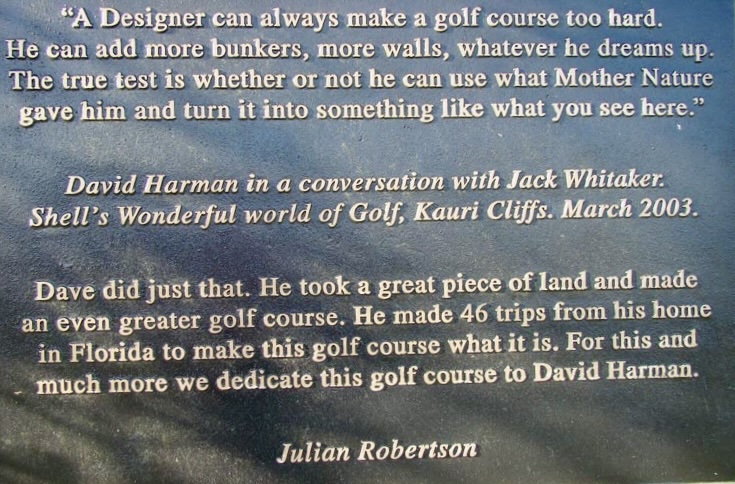
There’s another element to Kauri Cliffs that makes it, in my opinion, one of the greatest golf experiences on the planet. Of the 6,000 plus acres that make up the property, only a small portion is taken up by the golf course proper and the rest is still typical New Zealand farmland, mostly sheep and cattle pastures with some forested areas. Aside from the modest, by American standards, clubhouse and less than a dozen cottages discreetly sheltered almost out of view in a small forest several hundred yards away, there are no other man made distractions. Mr. Robertson resisted the urge to make the course a drawing card for a real estate play, whether that be residences or a mega-resort. The entire place has a sense of tranquility and oneness with nature that I cannot claim for Cabot Cliffs. which has not resisted the siren calls of real estate salesmen.
This shot of the clubhouse from the 7th tee is about the only time you’ll see a modern structure and actually it’s pretty damn nice in its own right.
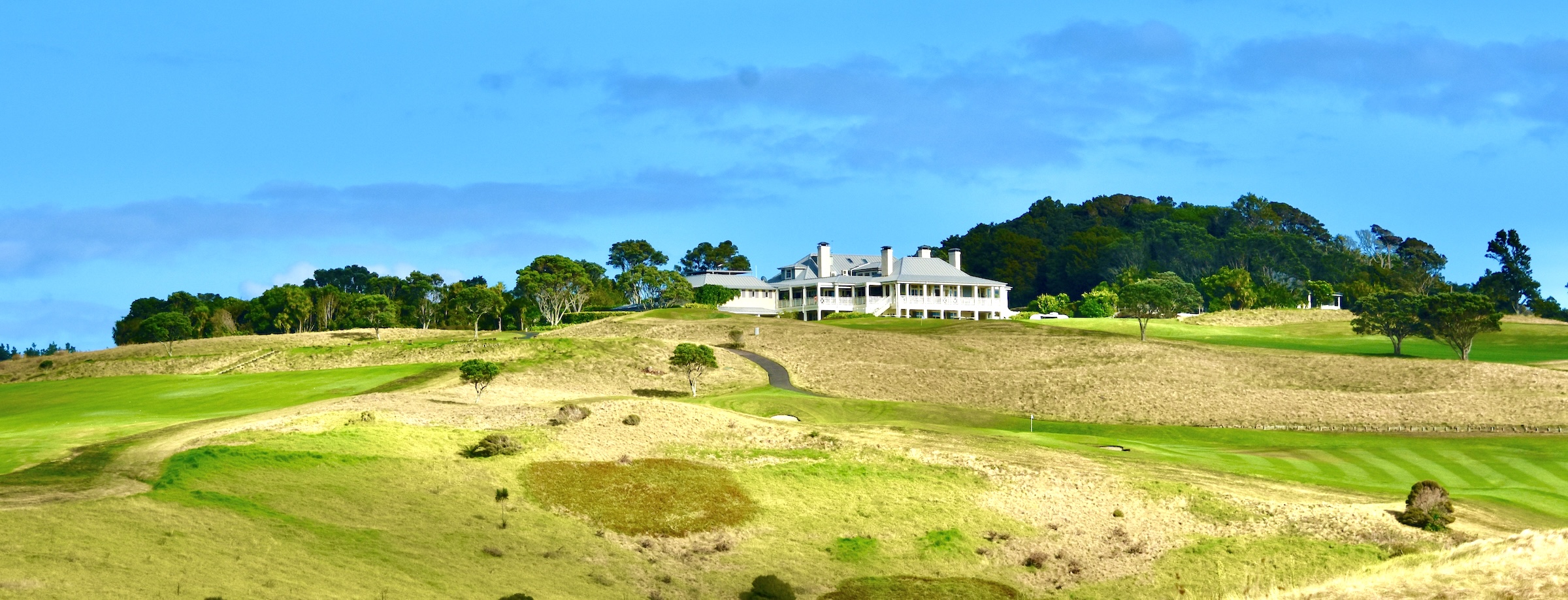
A couple of points before getting to the course proper. Finding Kauri Cliffs is not that easy even using GPS. There is no signage indicating where to turn off from the secondary road you’ll be on after leaving the main Northland highway somewhere after Kerikeri. At some point, as you pass over cattle gates and one-lane bridges and there’s nothing but farmland, you might begin to doubt that there could possibly be a world class golf course at the end of the road. Bottom line is, if you are coming from say Paihia or some other resort town in the Northland, give yourself plenty of time to find the place. Second point, bring your own range finder. The carts at Kauri Cliffs don’t have GPS and by design I presume, there is not a lot of signage or yardage info on the course. However, you will be given a yardage book which is a significant help, but no substitute for a modern range finder.
Once you do find your way to the parking lot at Kauri Cliffs and get your clubs onto a cart, ready to play, it seems like you are entering a whole new world. It starts at the driving range, which is without doubt, the most scenic I have ever warmed up on. While 99% of ranges are flat and pretty boring, Kauri Cliffs revels in giving you a feast for the eyes. I could have spent an hour just watching balls disappear down toward the sea, but since we were late in getting here we only had about five minutes.
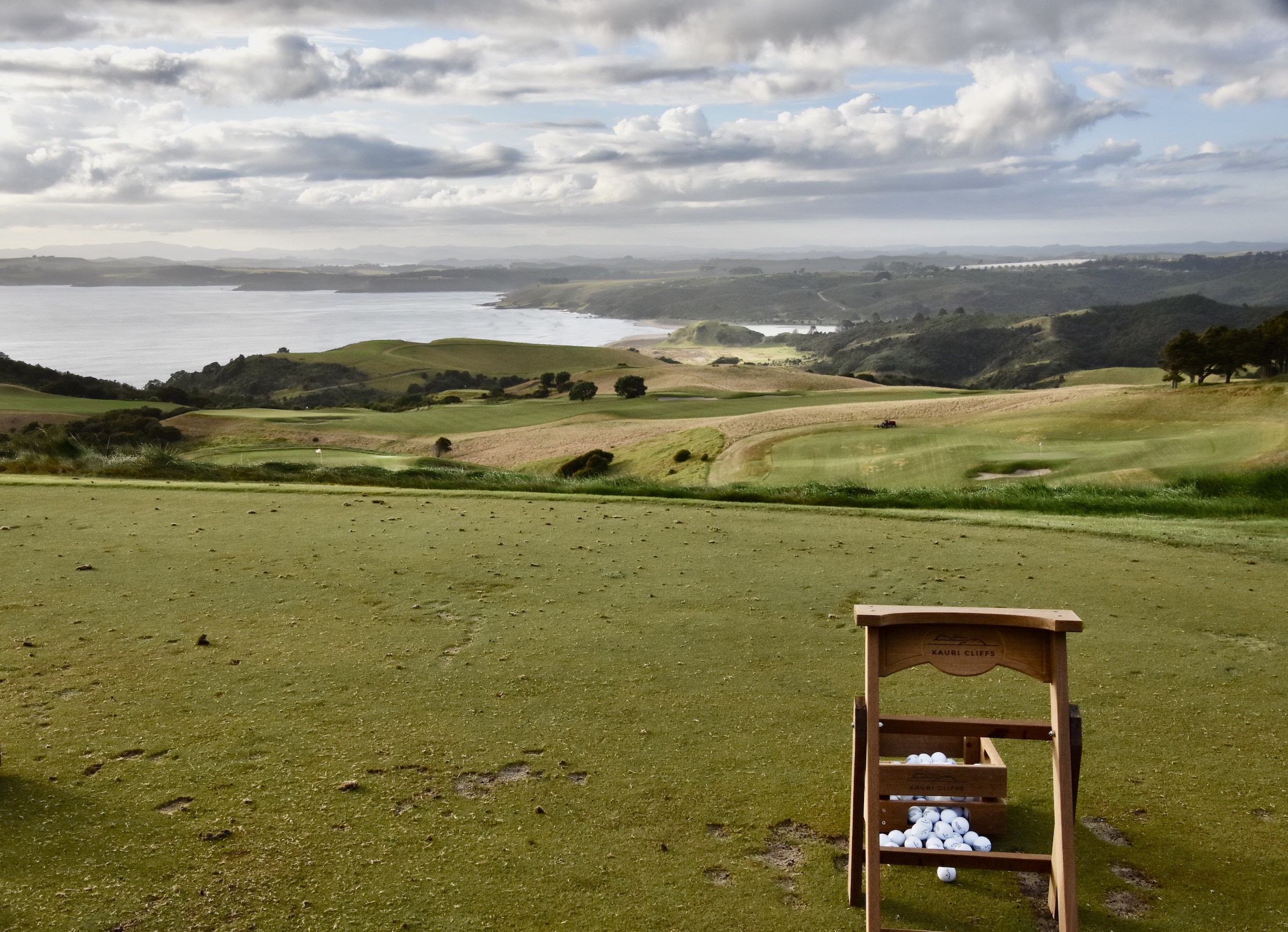
From the tips Kauri Cliffs can play as long as 7,139 yards and this is from where Fred Couples and former U.S Open champ Michael Campbell played a 2003 three match for Shell’s Wonderful World of Golf that Golf Pass rated as the third best venue ever featured on that venerable program. Only Pebble Beach and the Old Course at St. Andrews came out ahead of 37 great courses rated by Golf Pass.
There are five sets of tees and I will play from the greens which measure just over 6,000 yards. OK, enough talk, let’s play Kauri Cliffs.
Kauri Cliffs # 1 Takou – 392 Yard Par Four
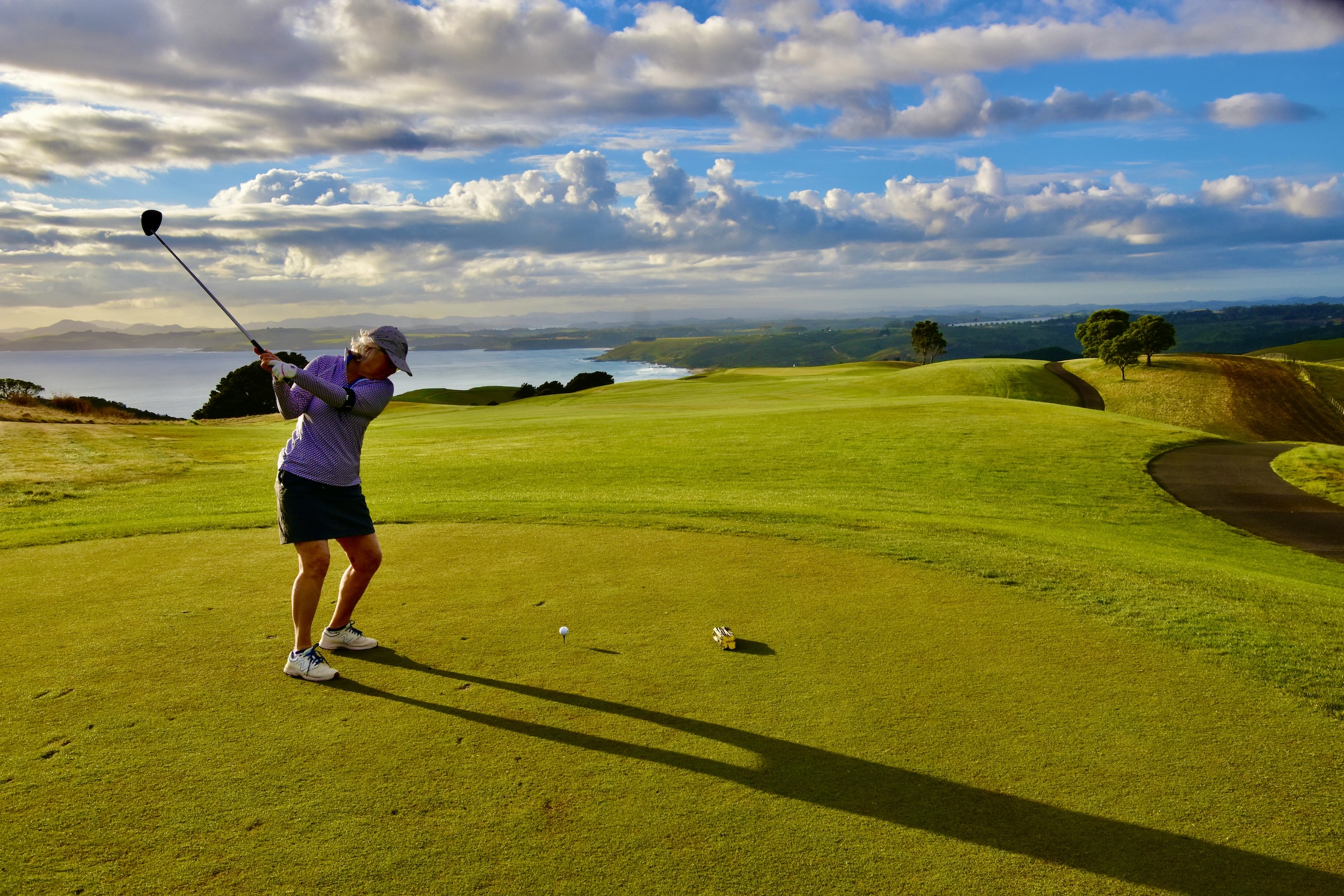
The first thing to note is that it is a gorgeous day in the Northland with no wind which would make the course much more difficult, especially the first time you ever played it. I don’t know who to thank, but we simply could not have better conditions for playing and appreciating the beauty of Kauri Cliffs.
This is the highest point on the course and offers the first of many panoramic views of the meeting of land and sea, in this case where the Takou River enters Takou Bay far in the distance. Although the photo doesn’t show it, there is a drastic drop off to the right, but the fairway is aligned so that it should be easy to avoid with everything kicking to the left. With the declivity, a decently struck drive should get a ton of roll and you’ll start off feeling very good about your game and I do have a soft spot for courses that start off like this.
One thing the photo does show is the immaculate condition of both the tee box and the fairway, as you would expect of a course of this magnitude. The tee boxes were all stripped, levelled and replanted with a bentgrass strain in 2022 which essentially has made them almost as smooth as the greens. As of spring 2025, the fairways are perennial rye grass, but that will change later in the year when the fairways are switched to Bermuda, aka cooch grass in New Zealand, which is a more heat tolerant grass that requires far less water than rye. The change is not because there was anything wrong with the rye grass in terms of conditioning, although as some photos will show, there were some spotty areas, but rather strictly for environmental concerns about reducing water and chemical use. The people at Kauri Cliffs are very cognizant that climate change is real and are proactively addressing the challenges that brings rather than reacting after the fact.
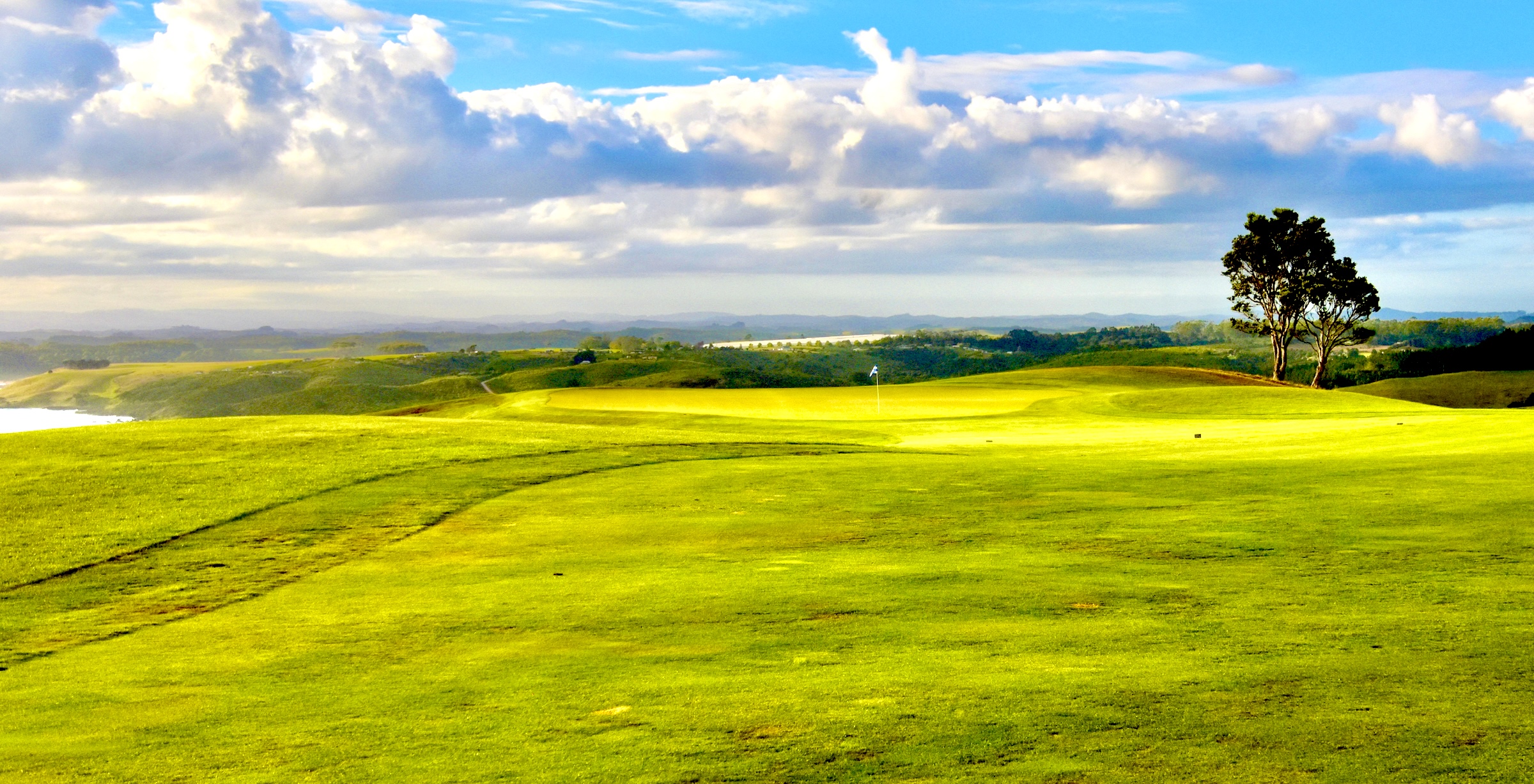
A good drive will end up down to a flatter part of the fairway leaving an approach shot something like this. Barely visible is a trap on the left side of the green which will actually prevent an errant shot to the left ending up 50 yards below the green. Coming up just short is not terrible here as you can putt from well off the green depending on the lie. The greens at Kauri Cliffs are pure distinction bentgrass which is a dense growing variety very much in favour today over more traditional grasses. It can be mowed extremely short making for lightning fast greens for tournament golf or left a little longer for a pure, but not exasperating putting experience.
Usually I remember a course’s greens more for why I didn’t like them than why I did. I think this is natural because you remember the frustration of too fast, too hard to read, too much break, too much undulation, poor conditioning, etc. etc. I can say without hesitation that I had absolutely no issues with the Kauri Cliff greens. They were the absolute Goldilocks of greens. Challenging yes, but not overly so. Not so monstrous that three putts were to be expected. I know it sounds weird, but I actually spent more time gawking at the scenery once I got to a green, than worrying about my putt. So, bottom line – the greens at Kauri Cliffs are not going to wreak havoc with your score and that’s in keeping with what David Harman and Julian Robertson wanted to accomplish here.
#2 Cape Brett – 395 Yard Par Four
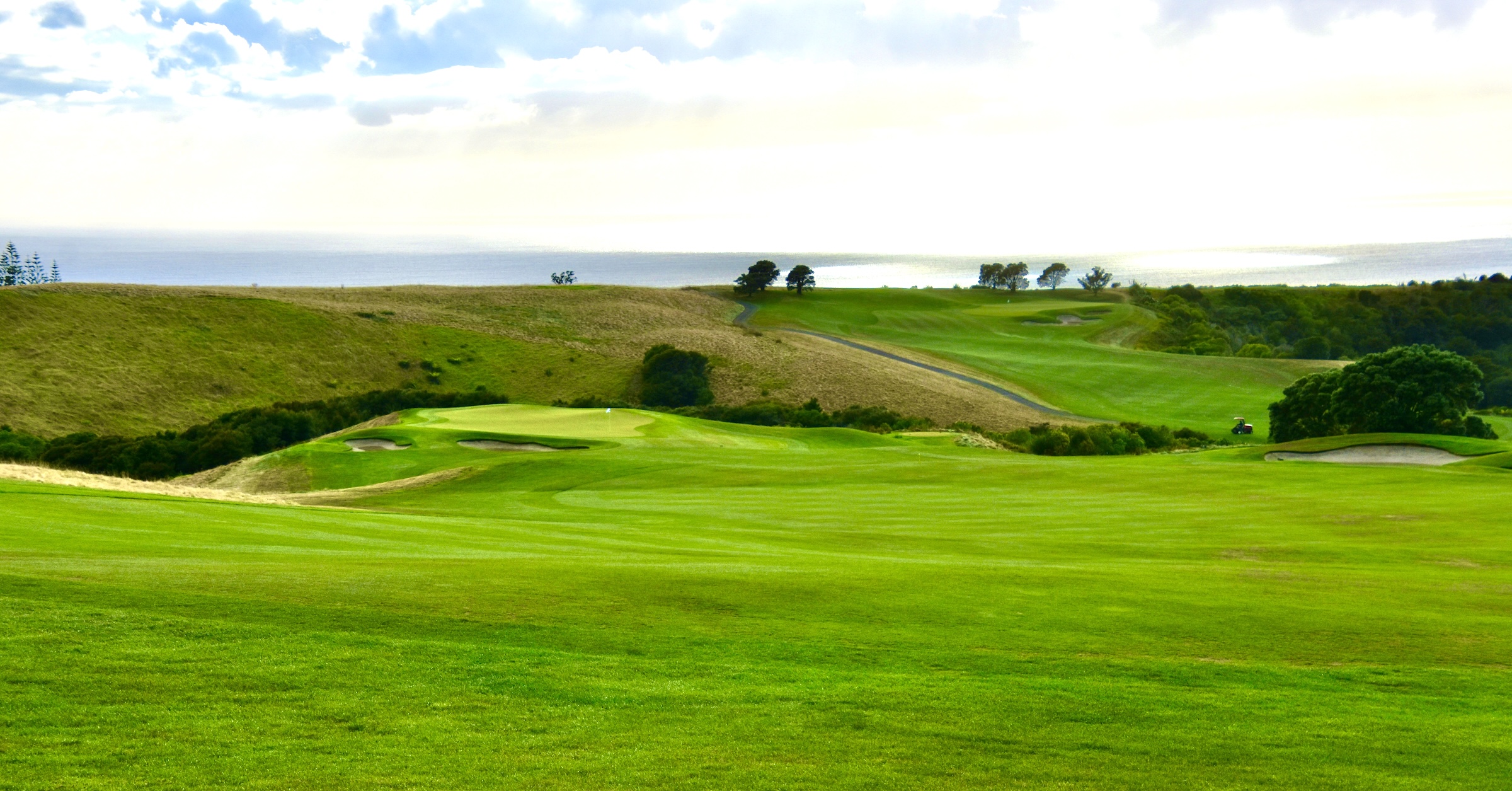
Don’t be fooled by this photo which makes it look like you could reach the green from the tee box. You’ll be lucky to get down to the fairway bunker on the right which is a good target. It’s 241 yards out and a drive coming up short of it will kick left leaving a good angle to the green.
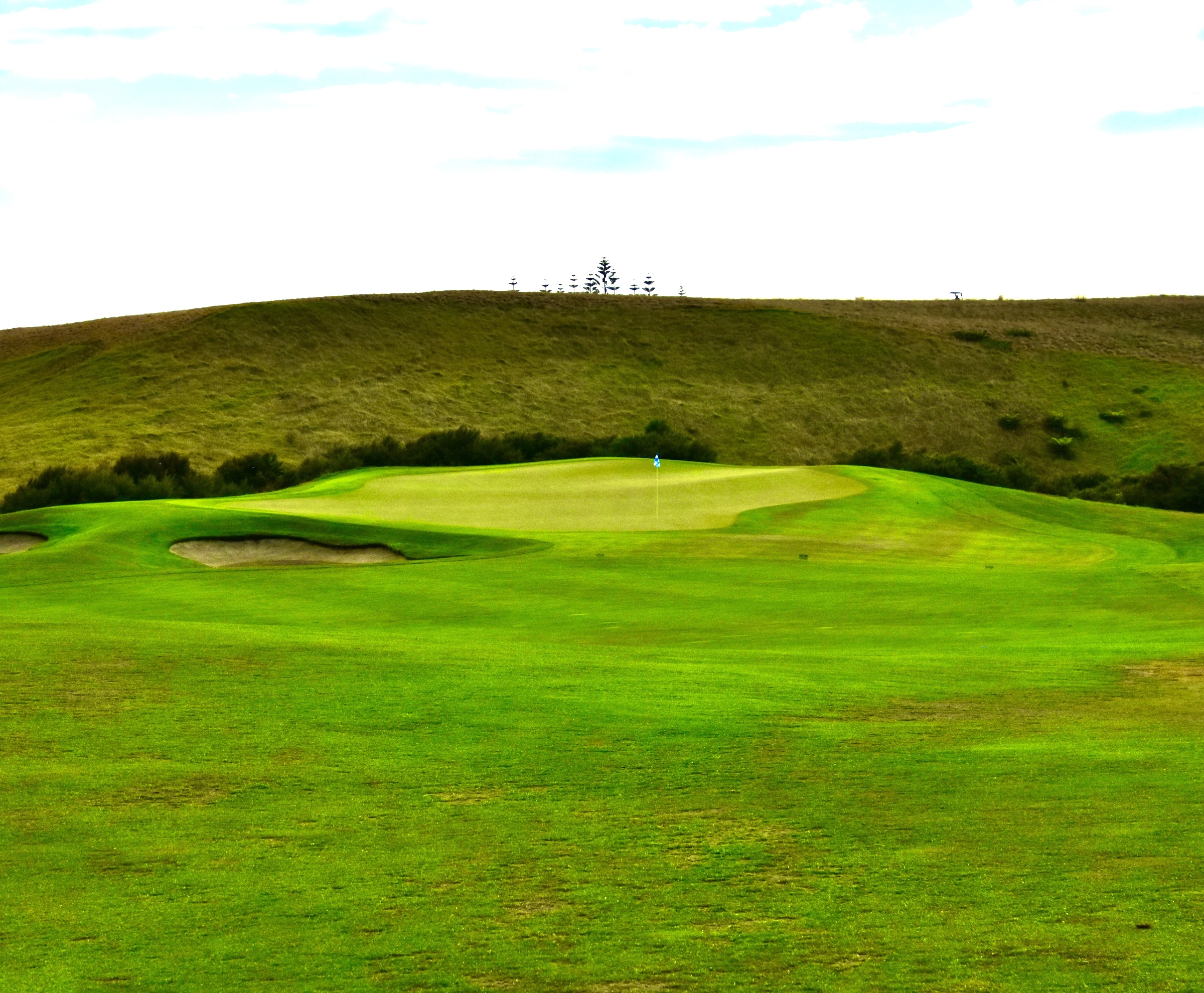
This is one of the shots where you will be glad to have a range finder. This is a much more tricky approach than #1. There is a steep slope behind and to the left of the green which has to be avoided at all costs. Right is a little better, but not much. The smart play is not to go pin hunting, but take a club you fell comfortable with, hitting the centre of the green and hopefully settle for a two putt par.
BTW Cape Brett is the headland in the Bay of Islands far to the south of Kauri Cliffs which you can see in the distance from the tee box. While you’re in the Northland. I highly recommend taking a boat trip from Paihia that will take you right out to Cape Brett and the famous Hole in the Rock.
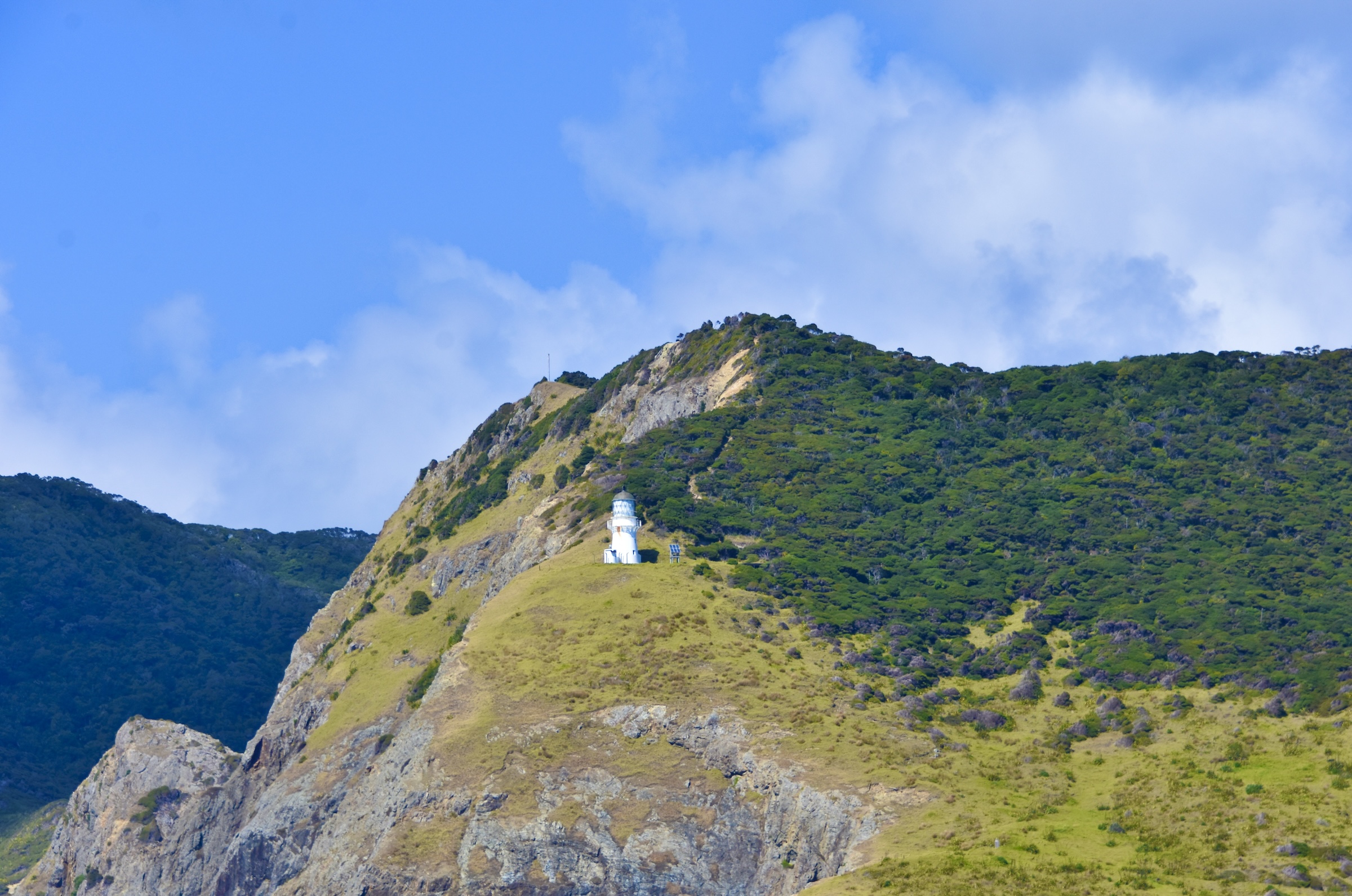
Kauri Cliffs #3 Puriri – 300 Yard Par Four
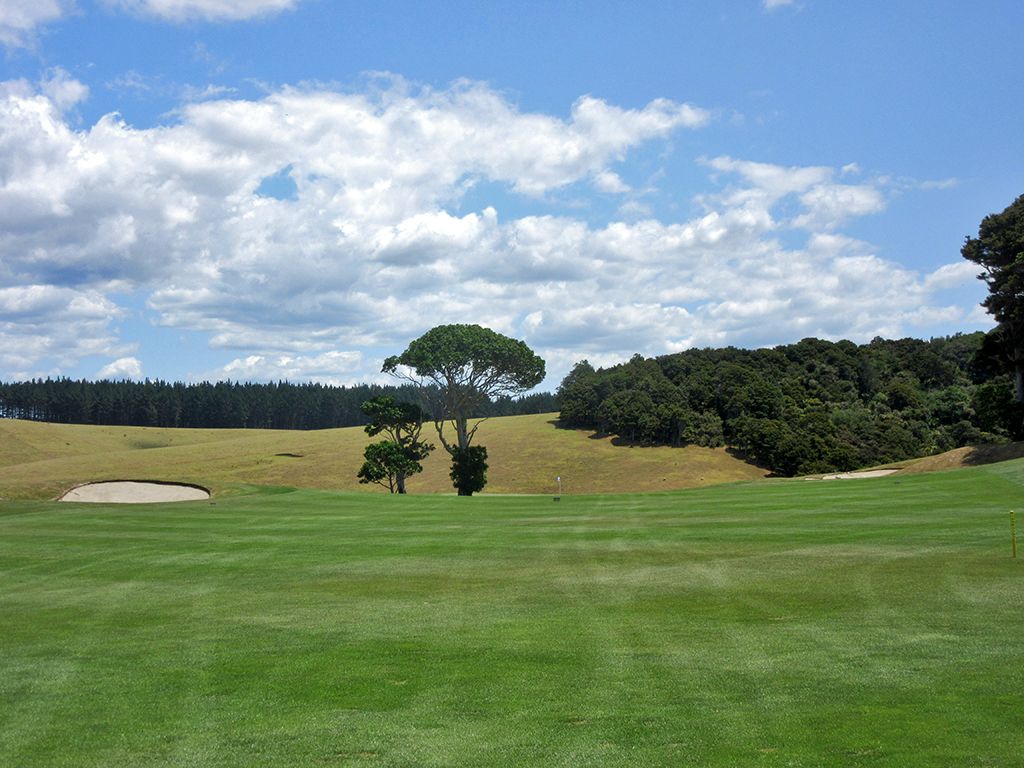
Wherever possible I try to use my own photos in my posts, but on occasion if I don’t think my own photos do justice to a hole, I will use a few from the great team at Golf Course Gurus who have beautiful photos of hundreds of courses around the world including this great selection from Kauri Cliffs.
#3 is the first of a number of quite short par fours at Kauri Cliffs that are collectively ranked the easiest holes on the course, in contrast to many courses where the par threes are often, mistakenly in my opinion, ranked as the easiest holes. As I get older and have the good fortune to play some of the best courses in the world, I have come to appreciate par fours that do not require ridiculously long drives to conquer. This is one such hole. You can see the pin straight ahead with a very wide fairway that might beckon a driver, but more sensibly a three or five wood. It is the approach shot on this hole that is the challenge.
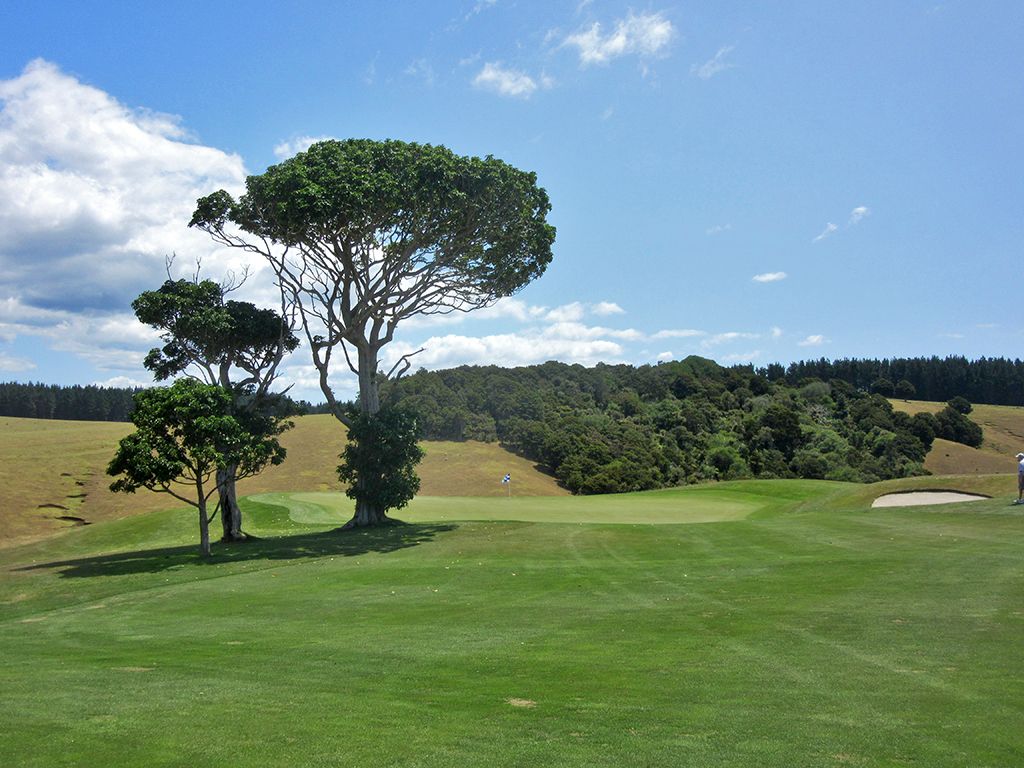
David Harman has taken full advantage of the ridges and valleys that, even without the ocean in play, make Kauri Cliffs special. This is the third consecutive green that sits atop a ridge with disaster awaiting should you go long on your approach. With the fairway slanting down to an infinity green this shot is much more daunting than it looks from this photo. It does offer the option of either pitching or chipping which adds to the confusion – some kind of wedge or bump and run? In retrospect, I don’t know why, but I found this to be one of the scariest second shots on the course.
BTW the name of the hole comes from the puriri trees that guard the green and forest in the background. They are related to teak trees and are most common in the Northland region of New Zealand.
#4 Cambo – 465 Yard Par Five
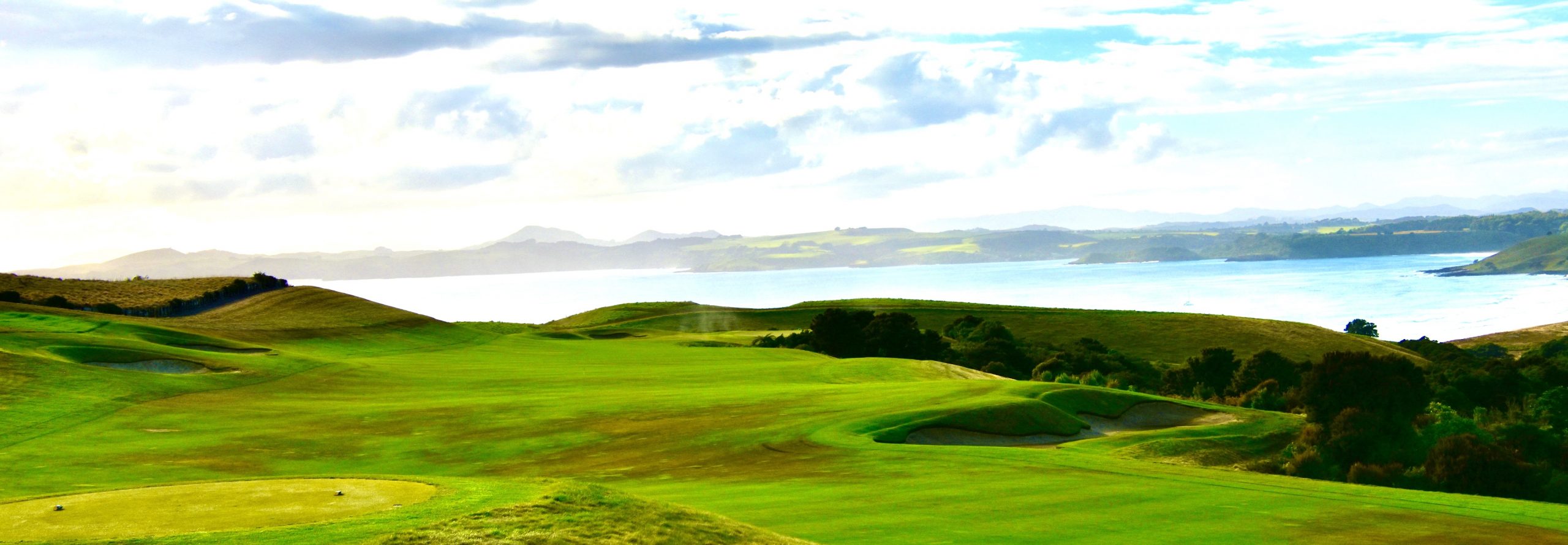
This first par five, named for 2005 U.S.Open Michael Campbell who absolutely loves it, is the first really sensational hole at Kauri Cliffs. After having the ocean at your back on #3, it comes roaring back into view on this hole which plays steadily downhill on a ridge that drops off sharply all the way down the right side. From the tee the you want to be as left as possible while avoiding the first bunker that is in play off the tee.
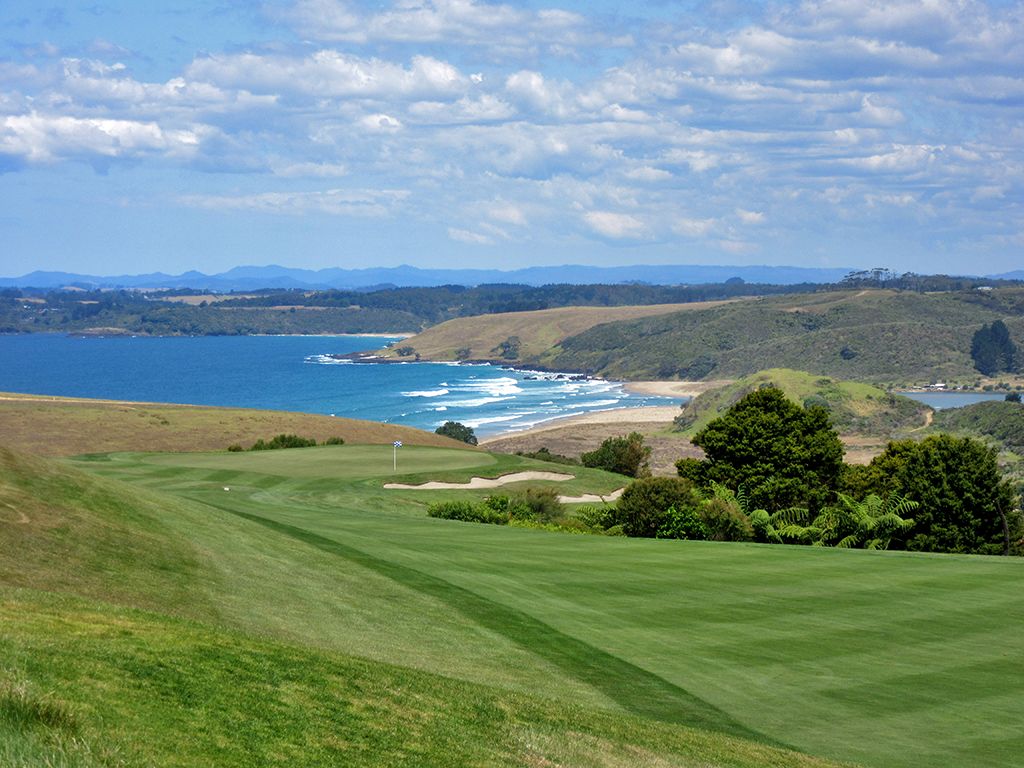
This is why this hole is beloved by long hitters. It is truly big risk, big reward. The ordinary human won’t be anywhere near this off the tee, but you will get to appreciate this view as you make your way to the green. The Takou River, which seemed so far away from #1, is now clearly in view as it enters Takou Bay in one of the best views on the course.
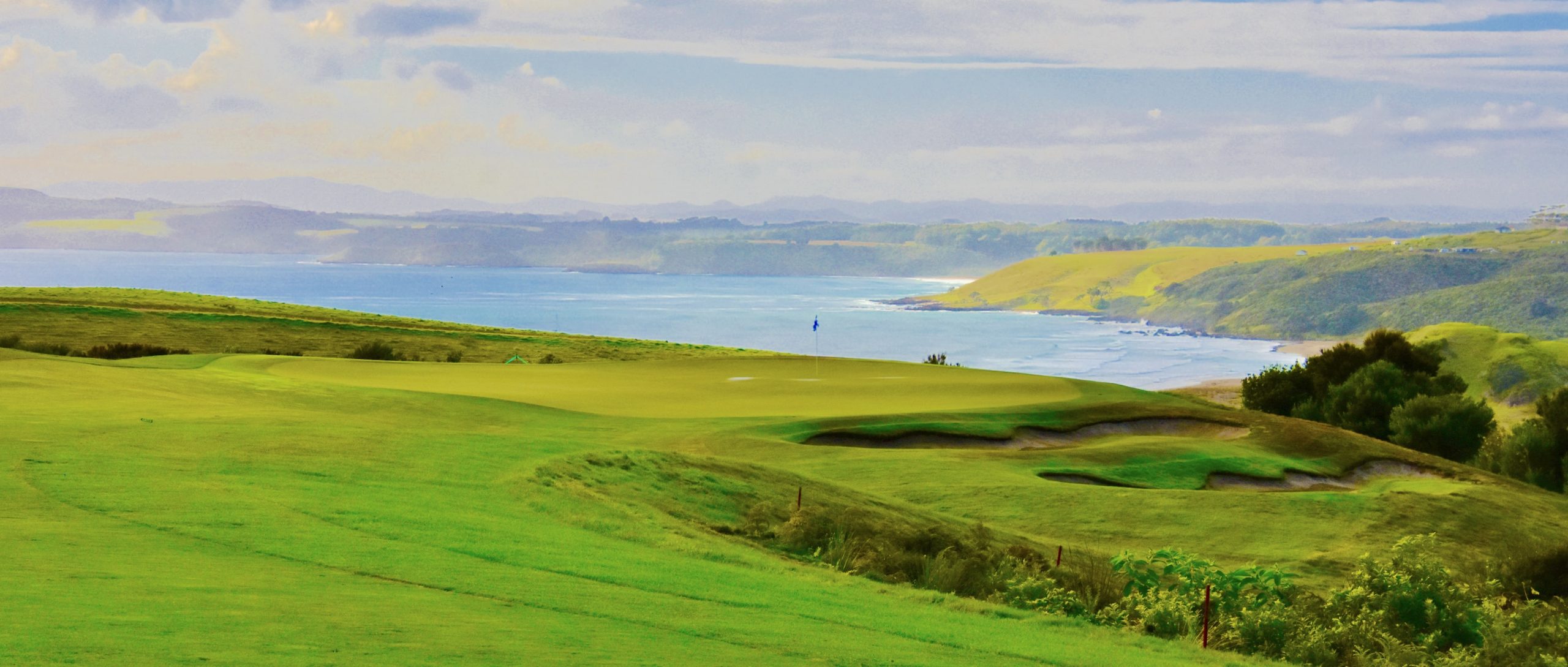
Back to reality, if you’ve managed to stay out of trouble with your first two shots you will have this something like this left for your approach. Staying well to the left will keep trouble at bay and the ball will roll toward the pin after landing. Trying to go right at it is only for the foolhardy.
Kauri Cliffs #5 Change – 130 Yard Par Three
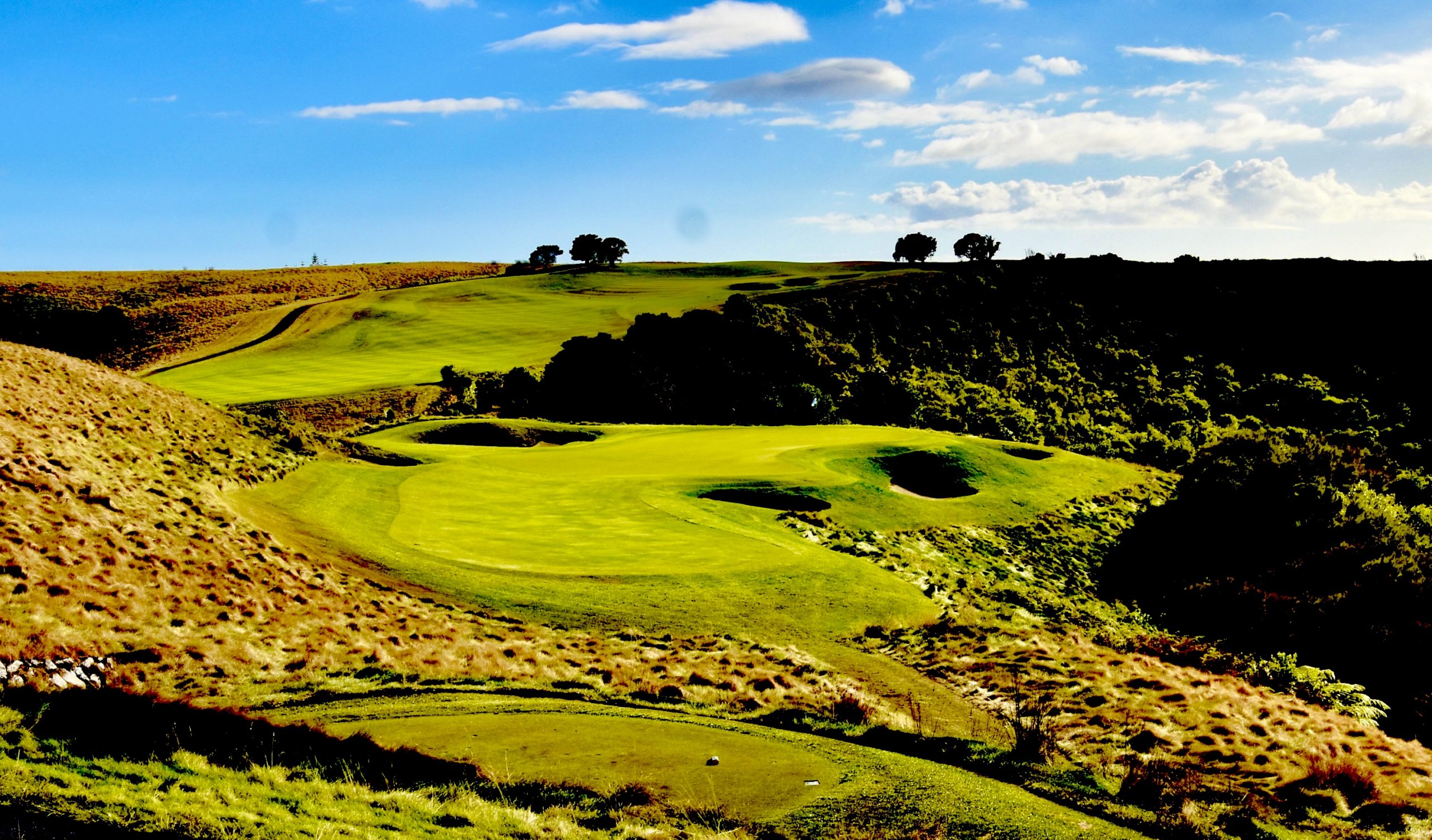
While only 130 yards long, this is one hell of a par three, especially with that pin placement. There is simply no room for error here and I have to admit to bailing by choosing a club that would come up short of the bunker on the left and hope for a two putt. It didn’t work.
#6 Falls – 336 Yard Par Four
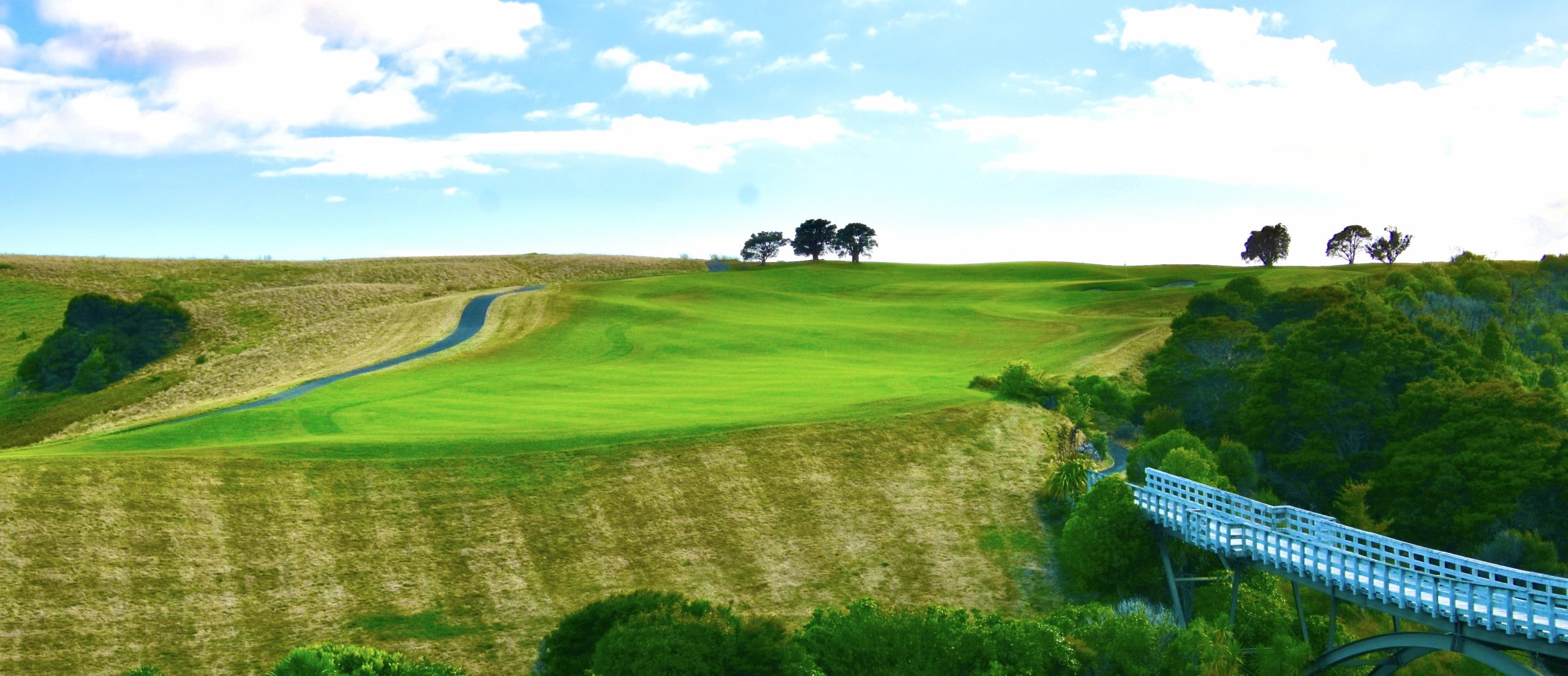
What goes down must eventually go back up and it starts with #6 which requires a driver off the tee to clear the chasm between the tee box and the fairway. This hole is very reminiscent of #7 at Cabot Cliffs although that carry is considerably longer. The issue here is how safe do you play it? There’s a lot less to make the fairway on the left than on the right, but then you’ll be facing a much longer second shot. I opted for safety over distance and had this approach shot.

Despite its short length, #6 plays far longer than 336 yards and you’ll need to take a lot of club to get up to the green in two. The target is the trees which are behind the green and once again there’s a severe drop off to the right.
Kauri Cliffs #7 Cavalli – 175 Yard Par Three
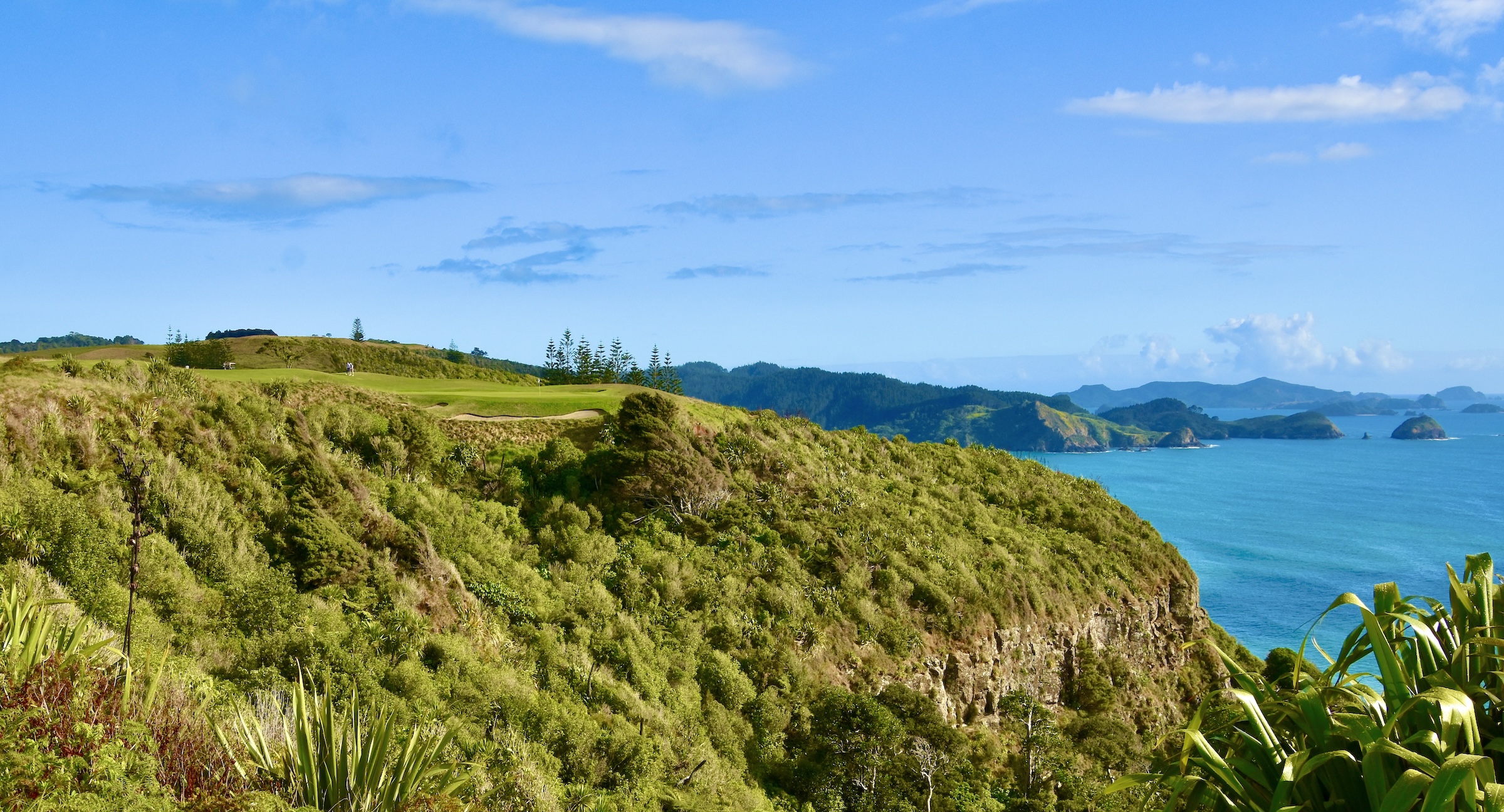
This is the signature hole at Kauri Cliffs and it has many similarities to the signature hole at Cabot Cliffs. Both involve very daunting carries to a partially obscured green. The difference is that the Cabot carry is only 113 yards while this one at Kauri Cliffs is a much more challenging 175 yards. Thank God there’s no wind.
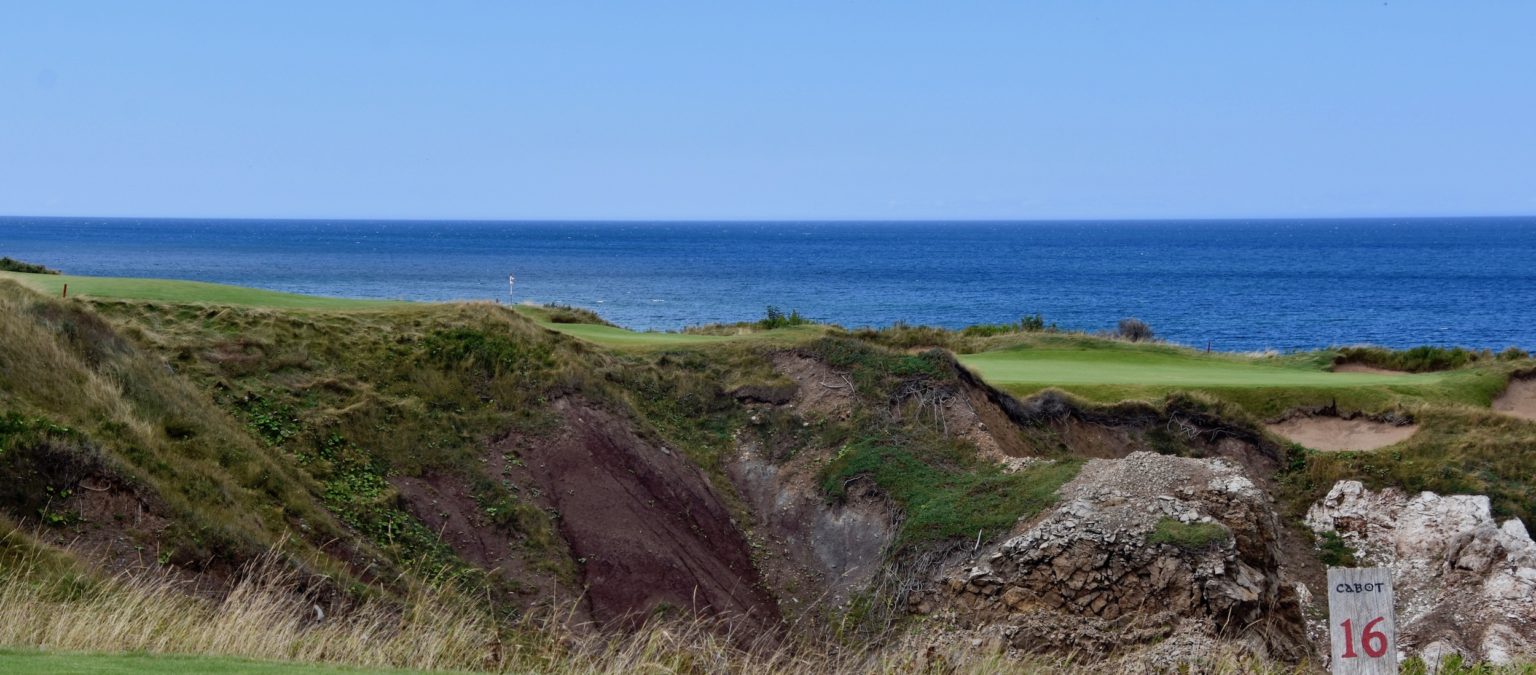
As with Cabot, the tendency is to stay as far away from trouble as possible by bailing out to the left and that’s what I did here. Just as at Cabot Cliffs, this hole is designed to kick the ball toward the green from the left so you’re not just chickening out. The result was two putting from just off the green for a par. In terms of the views from each tee box, the honours have to go to Kauri Cliffs with its stunning backdrop of the Cavalli Islands for which the hole is named.
#8 Warrior – 494 Yard Par Five
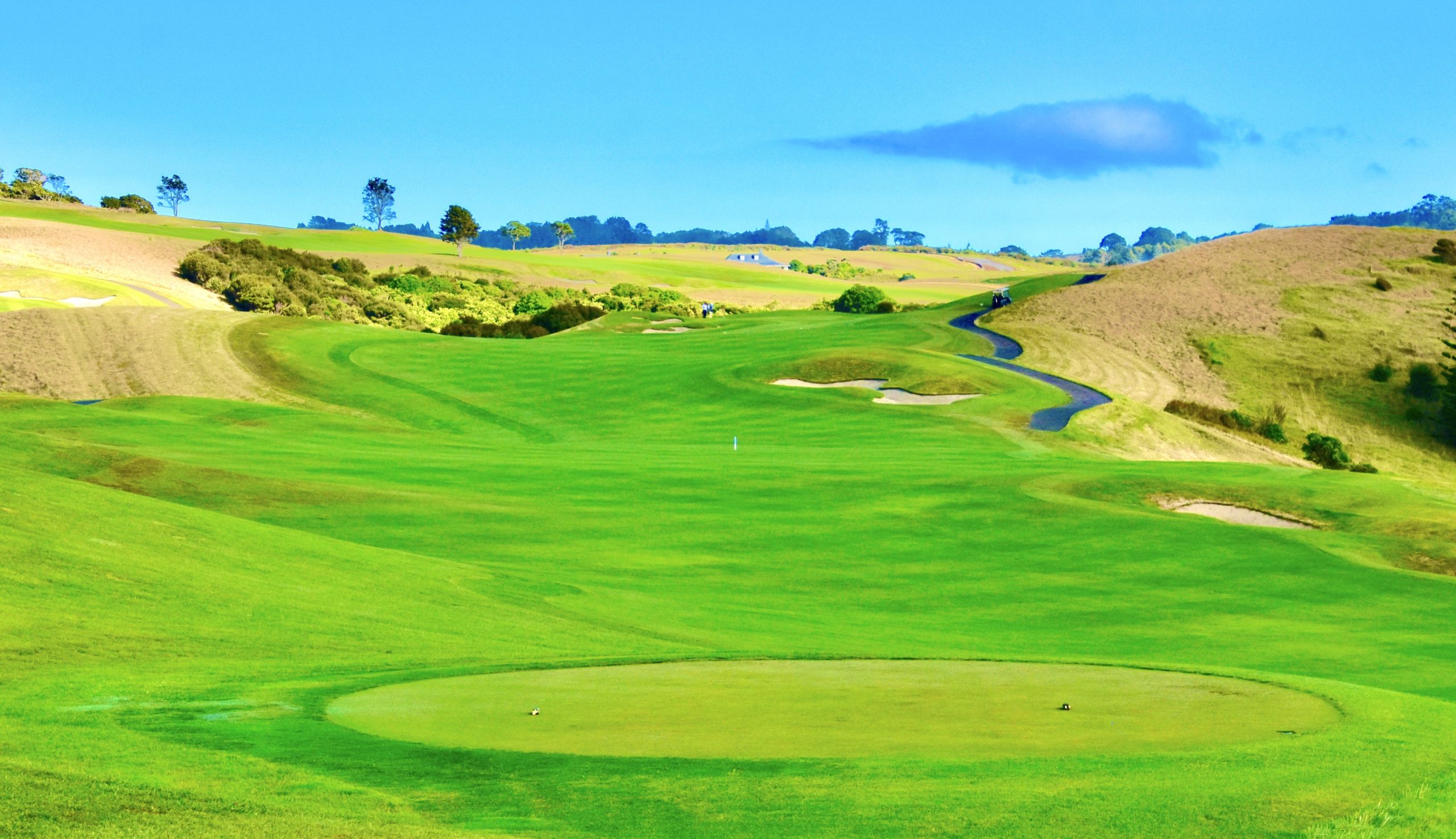
After the heart rate comes down from the exhilarating 7th, you have this very pretty look at the serpentine 8th hole that winds its way back up hill towards the clubhouse. Since there’s no way of reaching the green in two, the challenge is to just stay out of the bunkers by using a three wood off the tee and again for the second shot.
That should leave an approach like this from just under 100 yards to one of the few greens where there’s no trouble lurking other than the left side bunkers. I found this to be a very manageable par five if played sensibly.
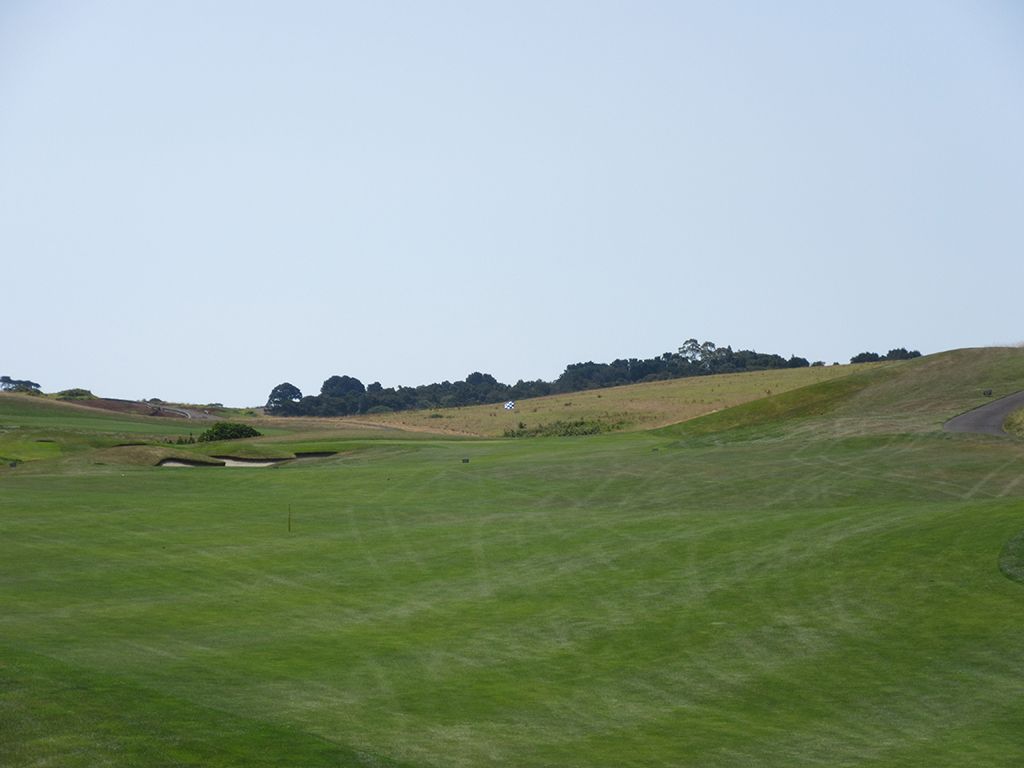
Kauri Cliffs #9 Giant Steps – 315 Yard Par Four
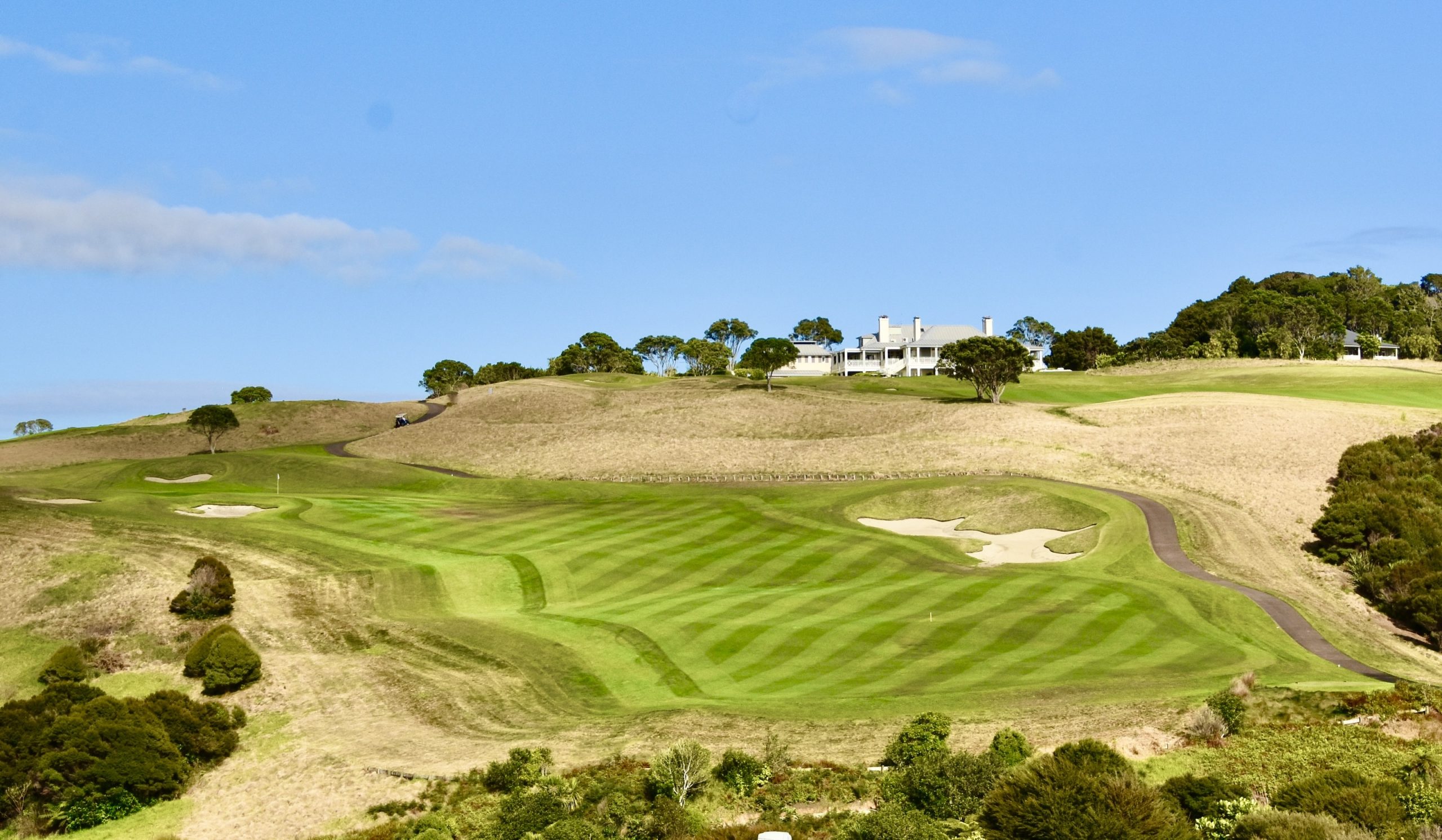
The front nine concludes with this gorgeous looking short par four. There is a carry from the tee, but nowhere as long as #6 and shouldn’t be a problem. The target is straight away to the right of the bunkers.
On the way to the fairway you cross over a bridge with this view highlighted by New Zealand’s famous tree ferns.
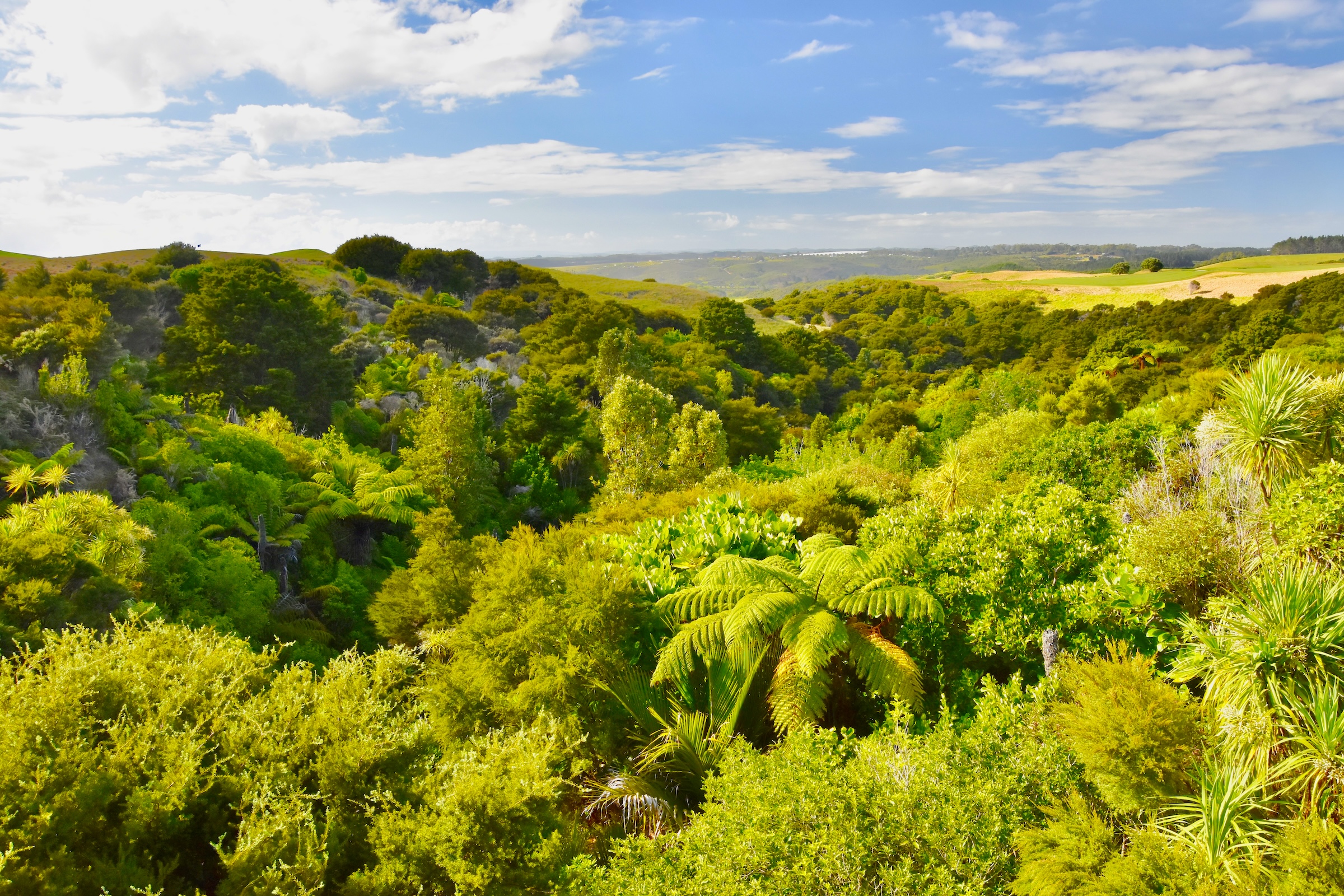
The approach shot on #9 is severely uphill and although not long, will require at least one extra club than the yardage calls for. Pick the right club and you just might end the first nine on a birdie note.
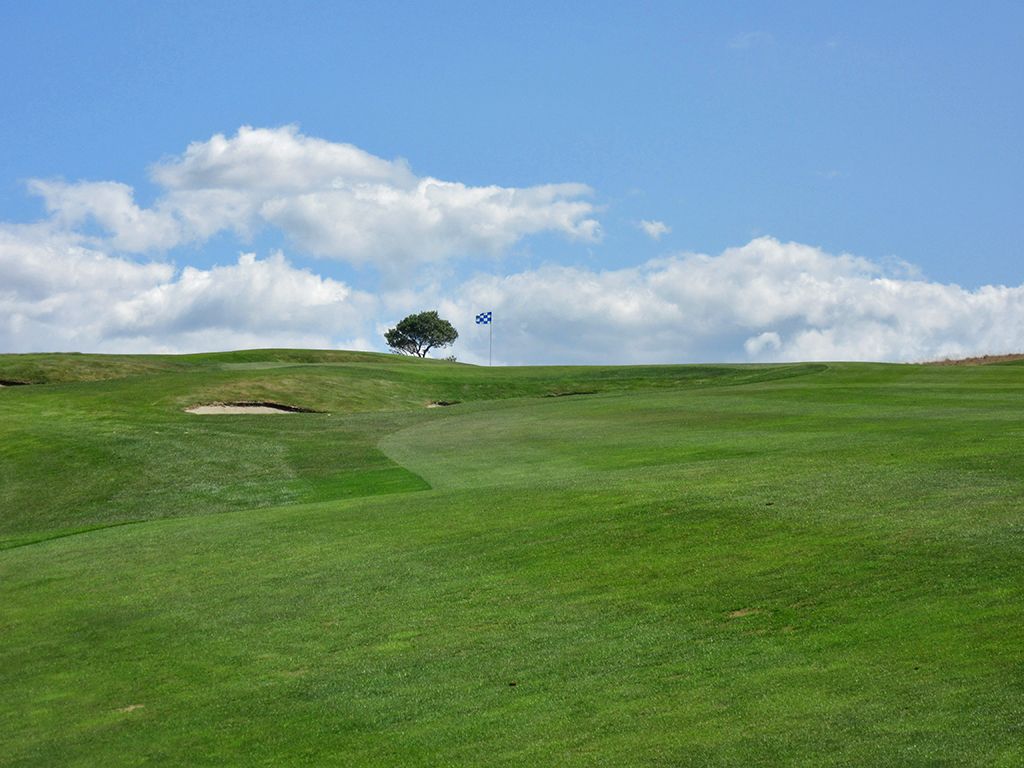
#10 Valley – 297 Yard Par Four
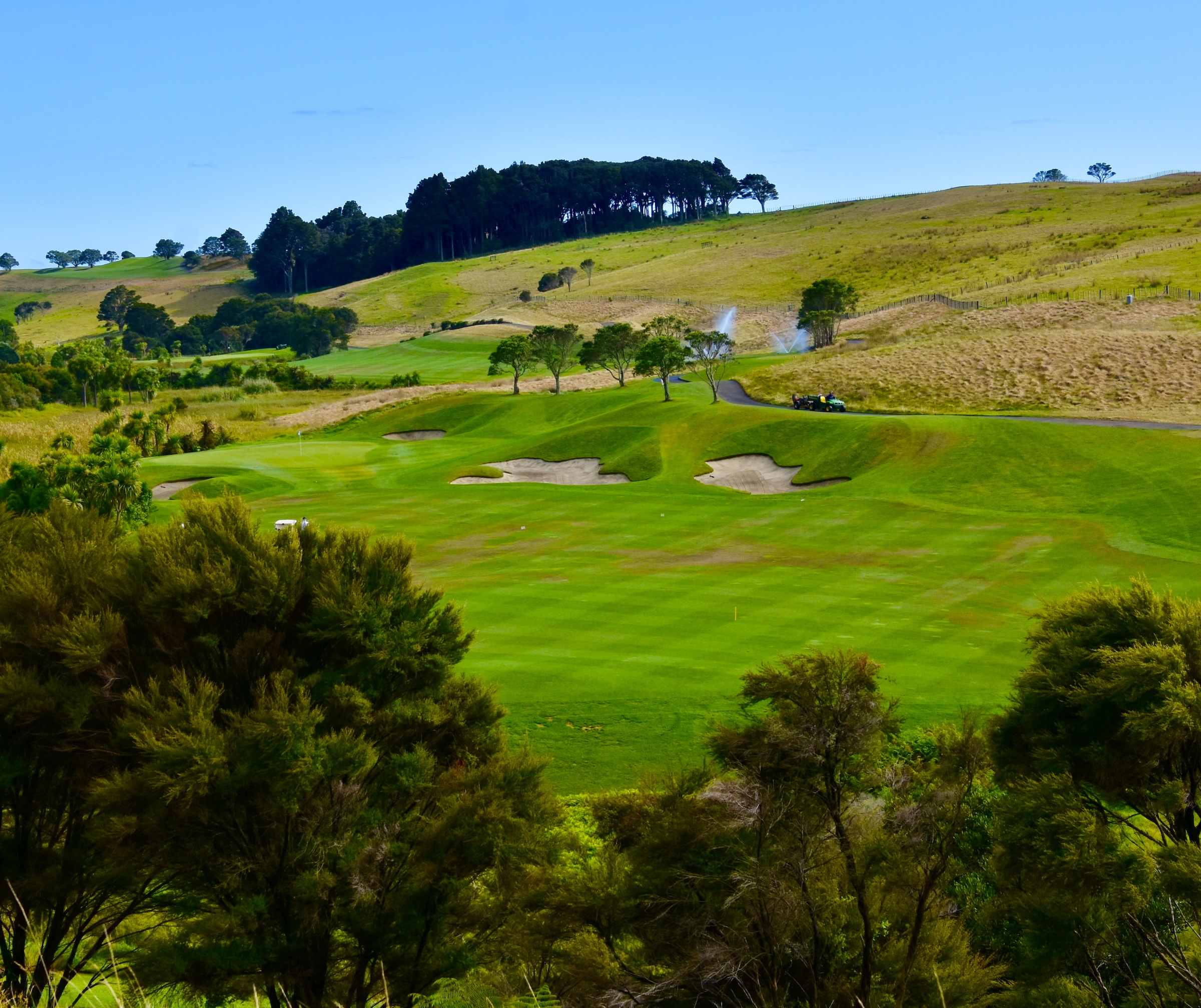
The back nine at Kauri Cliffs starts off with this descent into a valley and a short section of the course where the ocean is not in view in any direction. It’s a pretty easy tee shot that does not require a driver which would bring the traps into play. Just land almost anywhere on this generous fairway and you’ll have a flip wedge to the green and the second birdie opportunity in a row. If you think you are Tarzan you might even consider trying to drive this green to look for an eagle. It’s very unusual to see the two easiest holes on a course back to back, but if that’s going to happen I think the middle of the round is appropriate.
Kauri Cliffs #11 Totara – 346 Yard Par Four
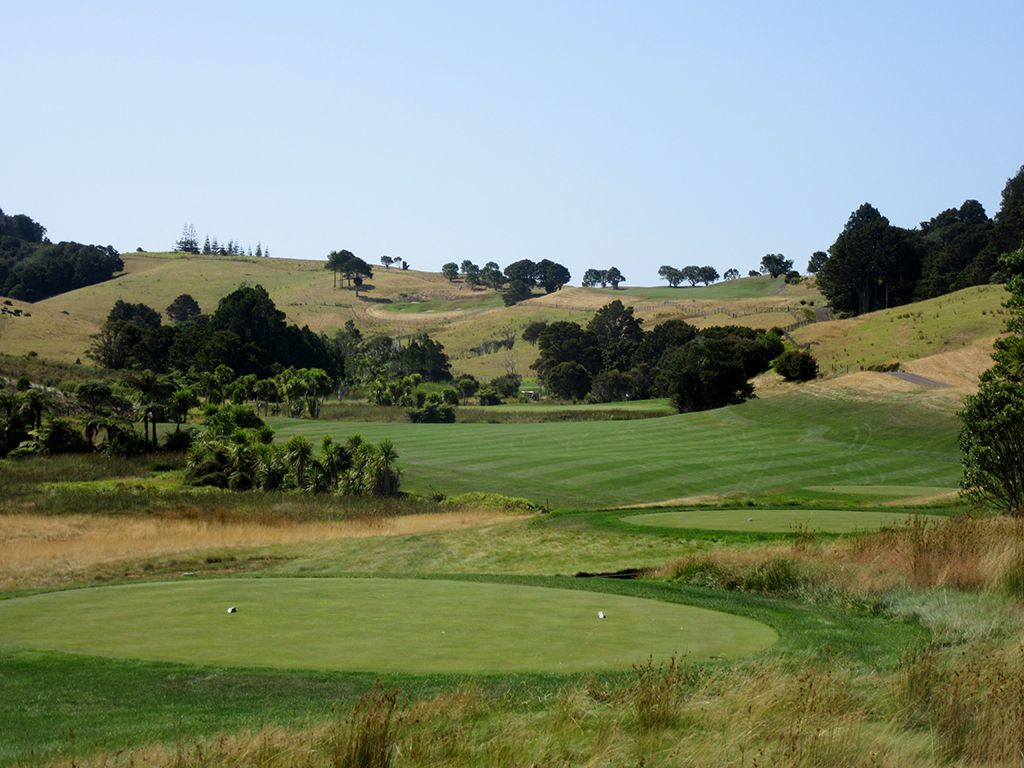
This is the second of four transition holes before you get back to the ocean views that will accompany you all the way home, but it’s not a throwaway hole by any means. You can see from the tee that the fairway ends some distance back of what is essentially an island green. This is another hole where a range finder will help in determining just how much room there is before the fairway ends. From the green tees it’s over 250 yards so driver is the club for most as there is next to no trouble off the tee. Anything to the right will kick back down to the fairway.
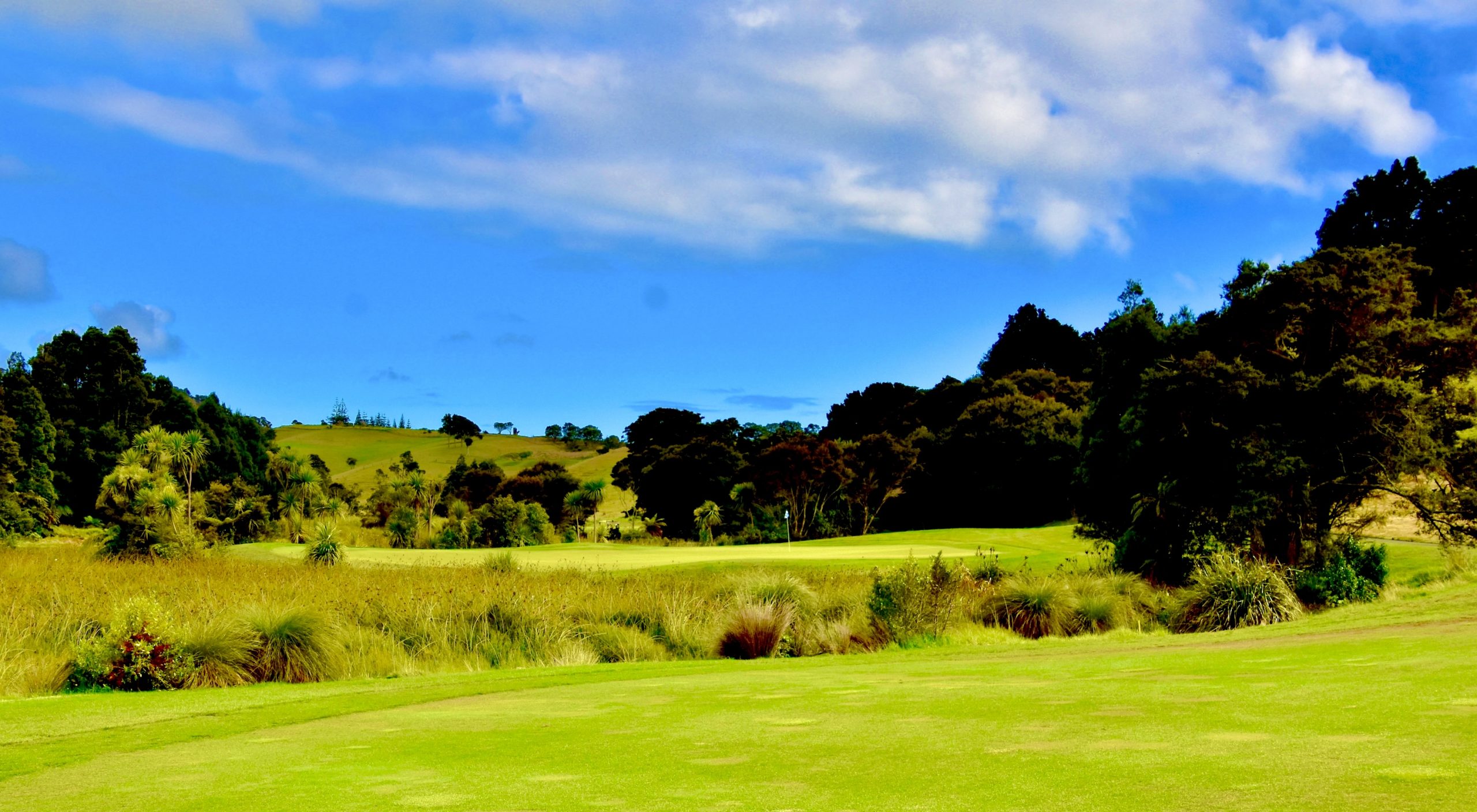
This is the approach shot on #11 which is quite doable as long as you don’t chunk it in the marsh. There is little trouble on the other side and with a green that slants right to left you might have a nice uphill putt for yet another birdie opportunity.
The name of the hole comes from the totara trees found in lowland areas throughout New Zealand.
#12 Raupo – 153 Yard Par Three
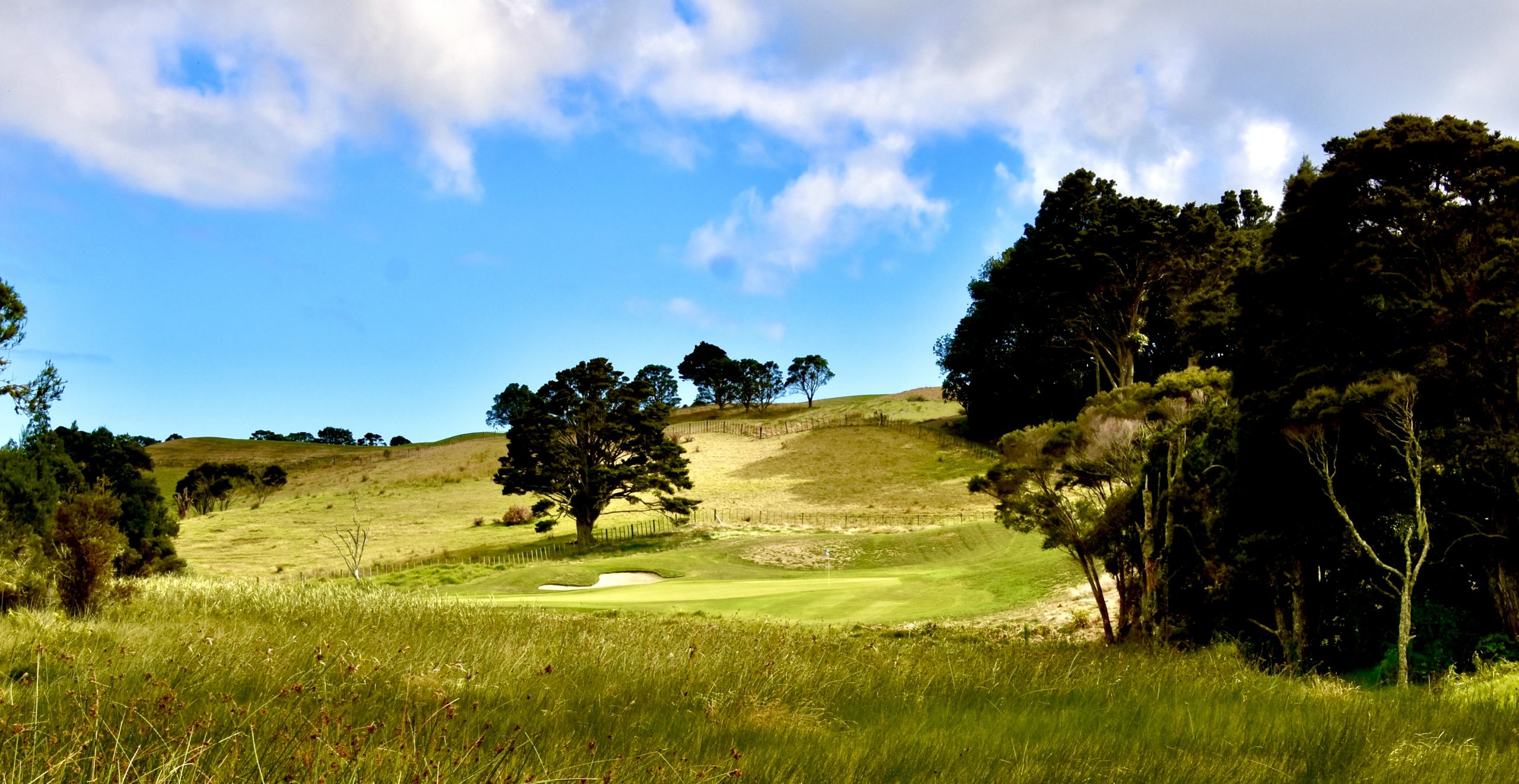
This first par three on the back nine at Kauri Cliffs is the third transition hole on the low lying part of the course. It is an all carry shot with very little room to miss short and a very strategic trap at the back that with the slant of this green will almost certainly gobble up anything long. Play this from the far left of the tee box and that should take the trees on the right out of play and allow one to take advantage of the right side slope.
Raupo is the New Zealand name for what we would call cattails and there are plenty of them on this hole.
Kauri Cliffs #13 Tablelands – 370 Yard Par Four
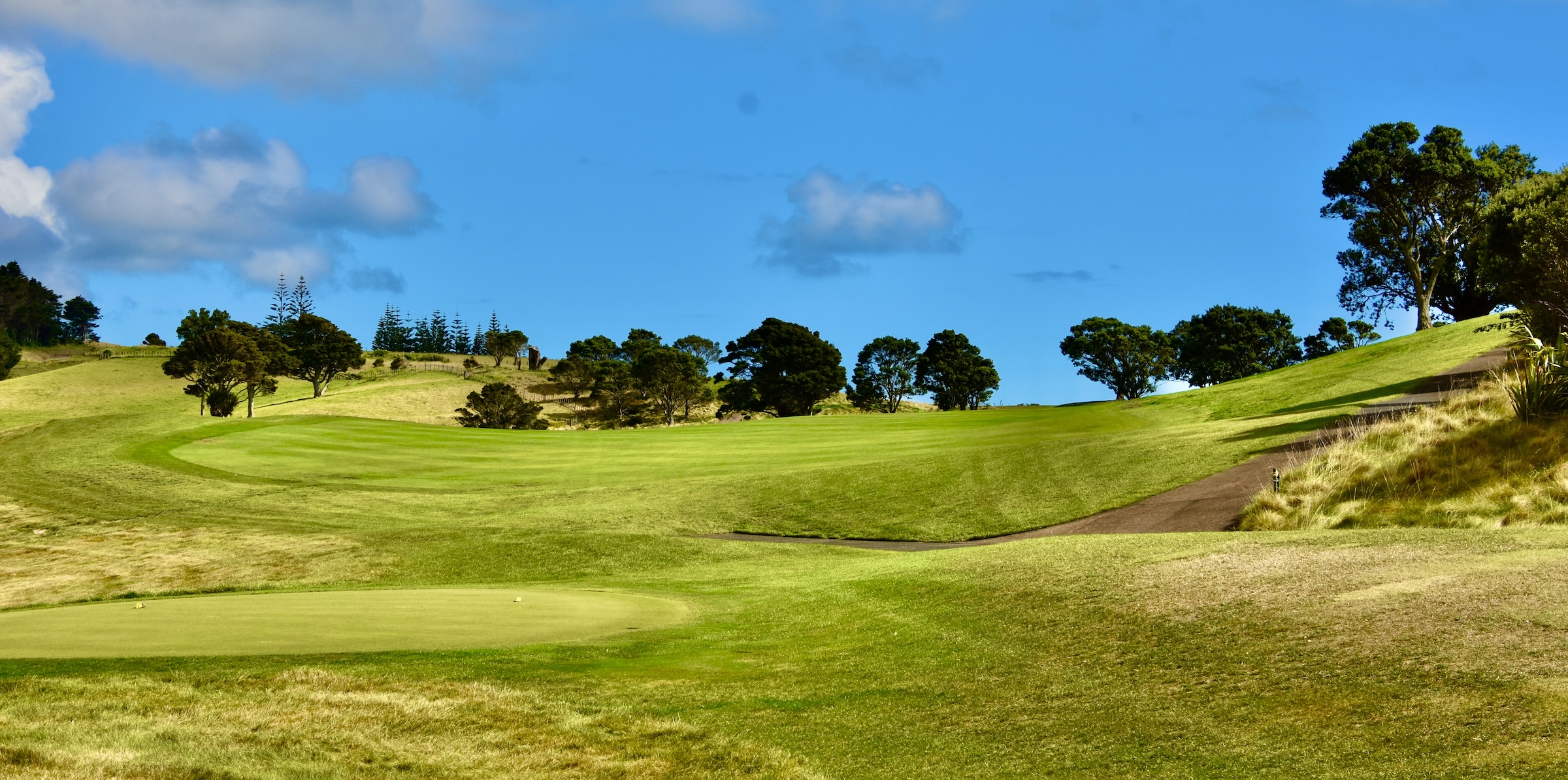
This is the final transition hole and in my opinion, by far the hardest. It plays severely uphill to a yardage that is closer to 400 than the stated 370, so don’t be surprised if you can’t reach the green in regulation. This is one of the few holes at Kauri Cliffs where you really do need to grip it and rip it. Fortunately David Harman has left lots of room to spray that drive without getting into any serious trouble.
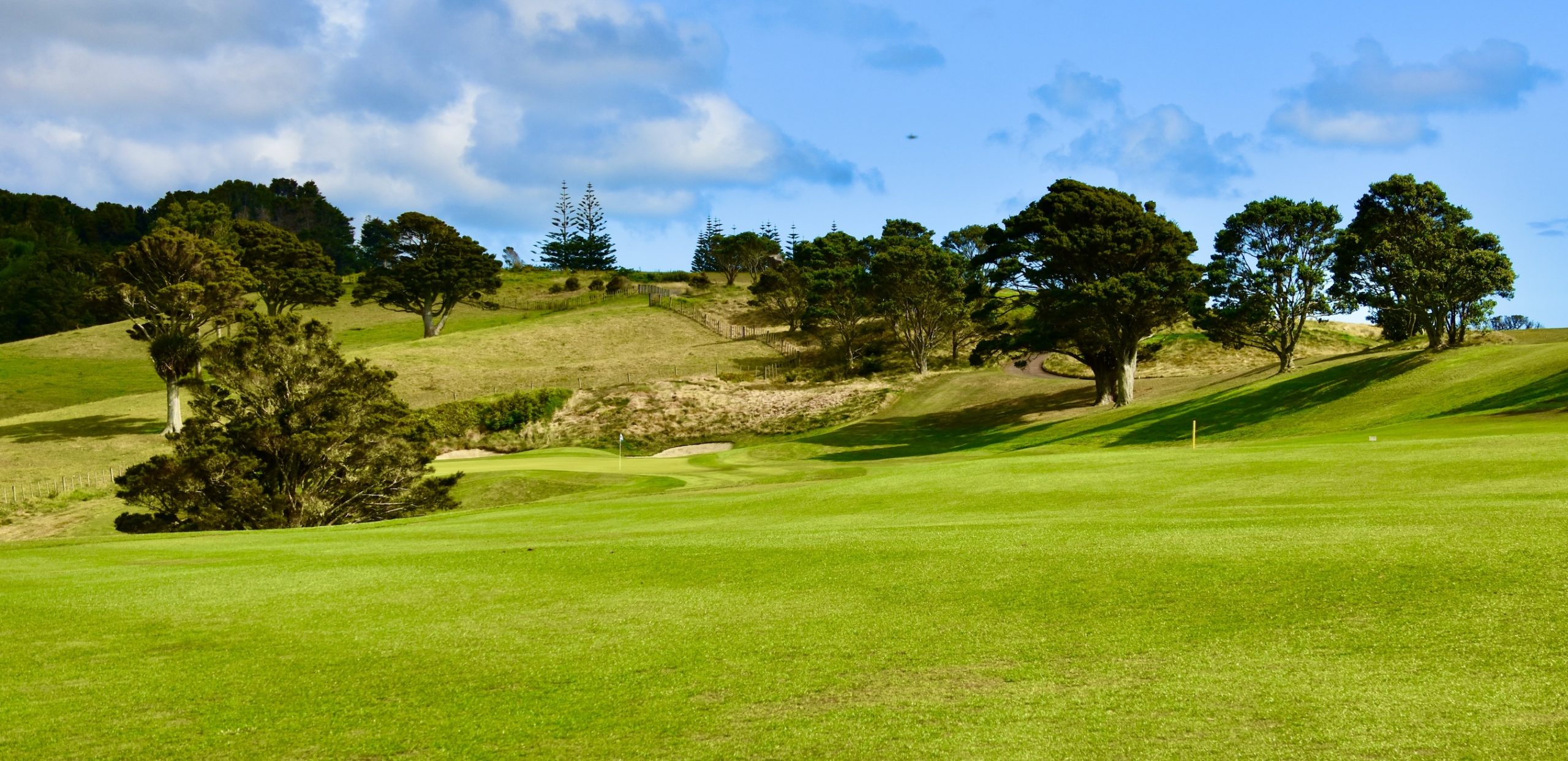
As you can see, even with a half decent drive I am still miles away from this most protected green on the course. Trying to go for it almost certainly means ending up in one of the five traps that guard all but the front. The sensible play is to stay right with a long iron or hybrid and hope for a favourable bounce toward the green. Even if you don’t get one, par is still saveable with a good chip and putt. Bogey is by no means a defeat on this hole.
As others have noted, you don’t necessarily have to have great ocean views at Kauri Cliffs to have a great hole and Tablelands is a great example of that.
#14 Waiaua Bay – 176 Yard Par Three
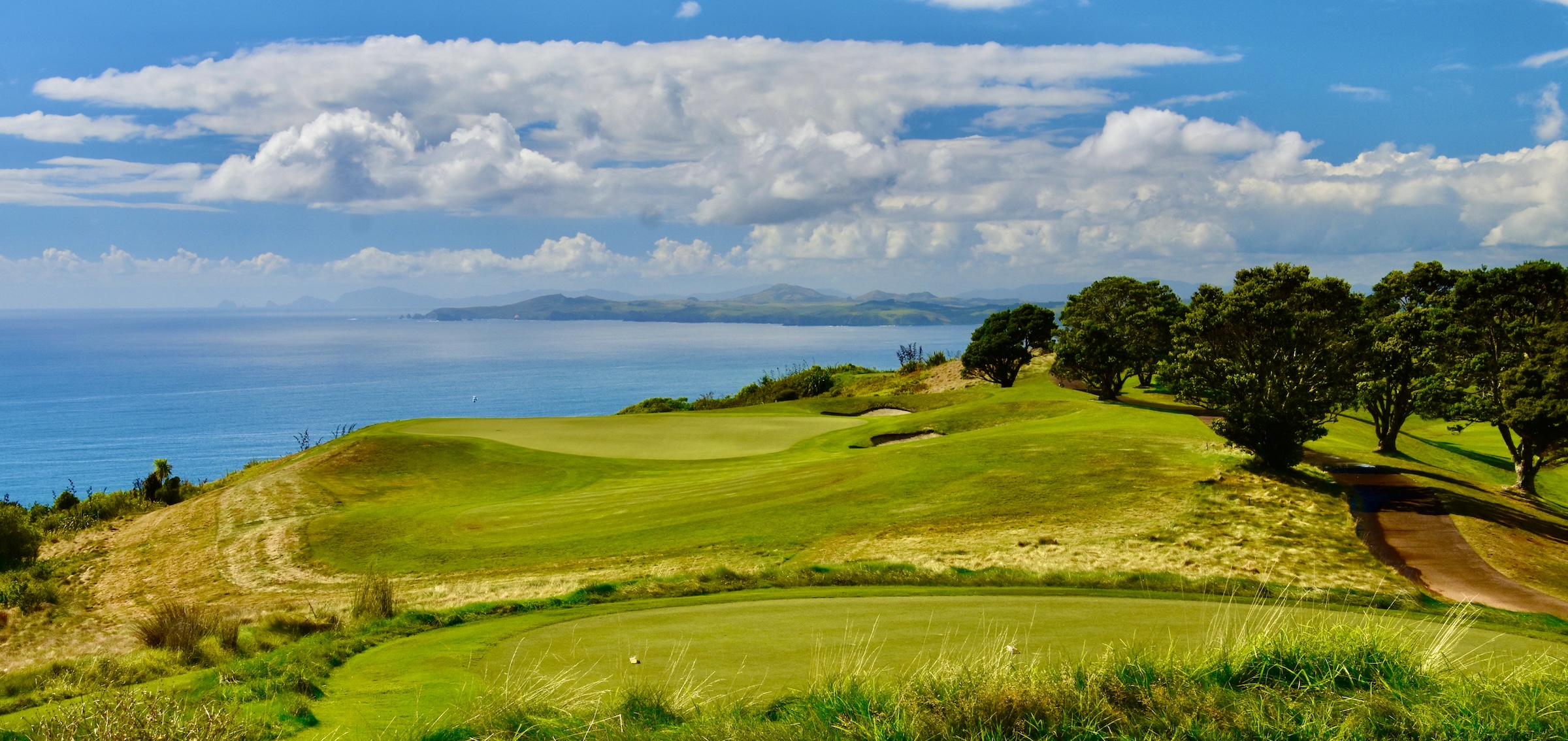
#14 is another of Kauri Cliffs ‘wowser’ holes with a simply breathtaking view of the ocean which comes almost as a shock as you make your way up from the 13th green to the 14th tee. You are now at the highest point on the cliffside portion of the course. Once you finish taking your photos, which is de rigeur on pretty well all of Kauri Cliffs seaside holes, you need to pick a club. It is quite downhill with nothing but disaster left or long. Two traps on the right prevent trying to hang right and bounce down onto the green, sort of the opposite of what worked on #7. Lastly, anything short is not going to kick forward but to the left, probably leaving a blind second shot to the pin.
In other words, you absolutely have to hit it and stick it on this hole. And I’m playing this on a day with no wind. Add that as a factor and this becomes one of the really great par threes anywhere. According to the scorecard it’s only the #15 hole in terms of difficulty, but I respectfully have to disagree.
Kauri Cliffs #15 Cook’s Hook – 513 Yard Par Five
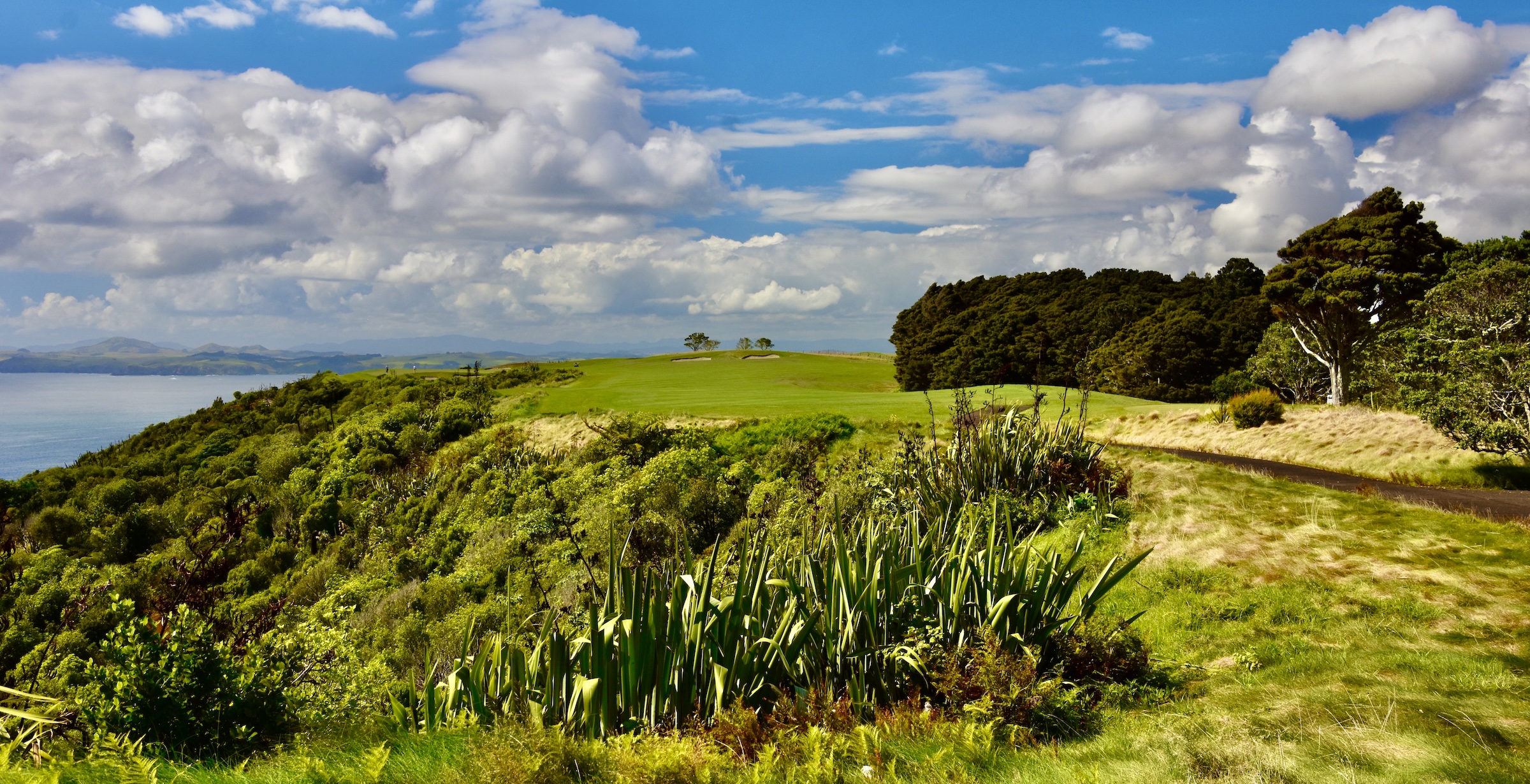
My natural ball flight is from right to left and for me this was one of the most terrifying drives I have ever had to attempt. In its own right this is the toughest drive on the course with the narrowest fairway and lost ball territory anywhere not on the fairway. It is a three shot hole that ends with an extreme dogleg left on the approach, which I presume is Cook’s Hook. A hell of a lot can go wrong on this hole, but hey, the scenery is phenomenal.
The forest on the right side of the fairway is 252 yards away so I took dead aim at it knowing my ball would veer to the left which it did leaving this for the second shot.
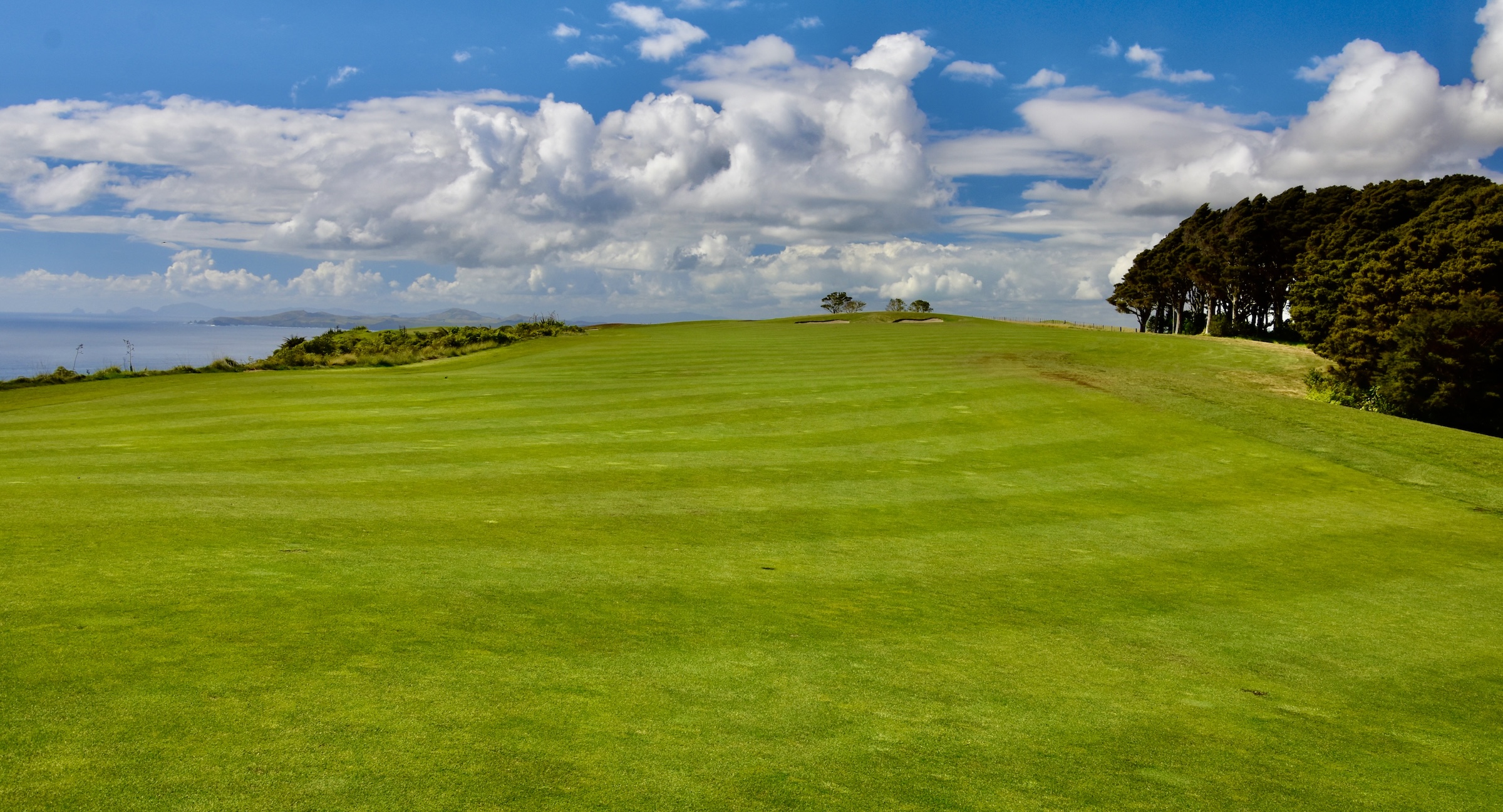
The target now is straight ahead at the traps and trees which are not reachable, again starting off well to the right to drift back to the centre of the fairway.
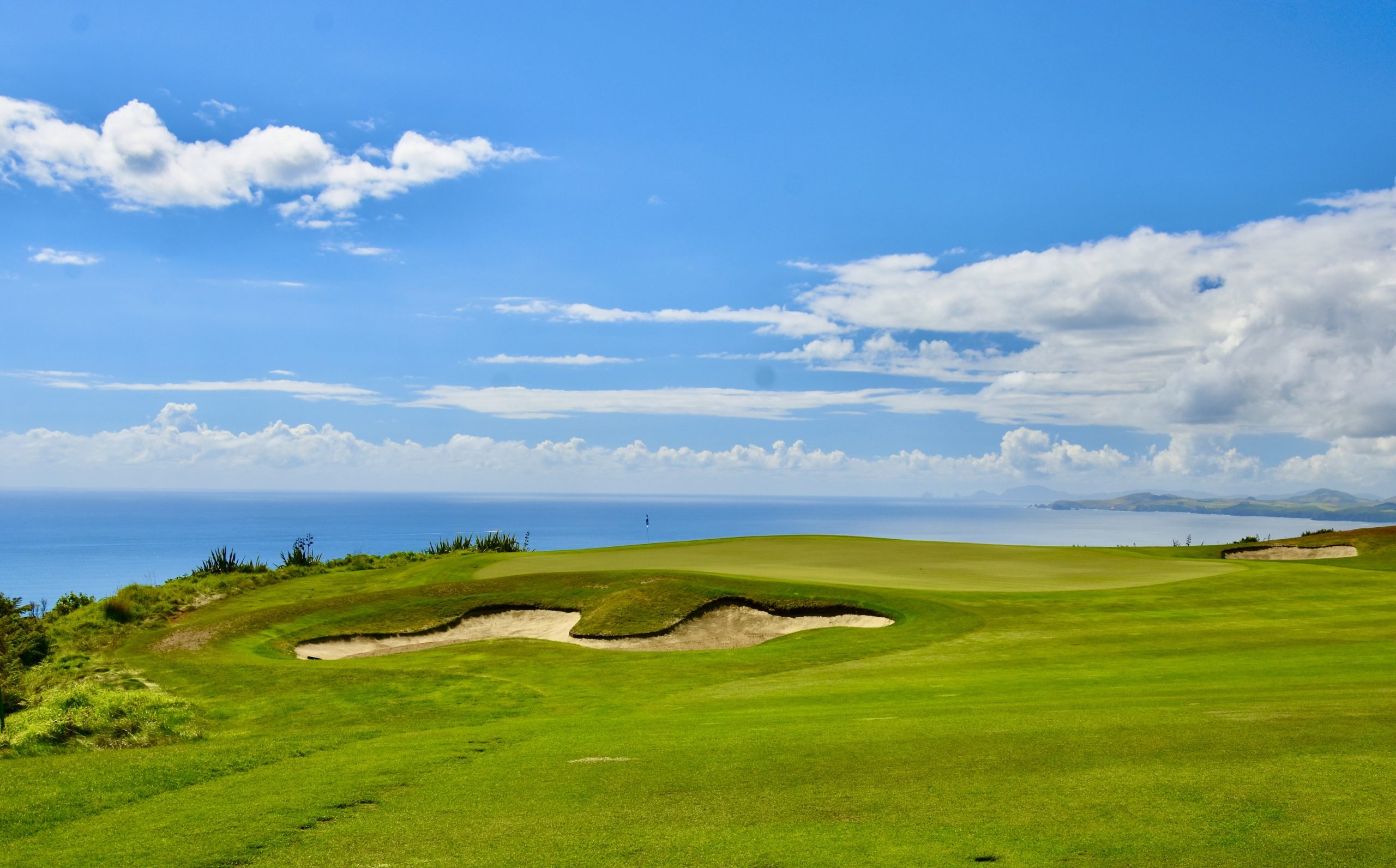
Even playing as conservatively as possible, my second shot still came too damn close to the left edge for comfort leaving an approach shot over the formidable trap on the front left of the green. The upside is that this is a huge green with plenty of room between the fringe and the pin. After being quite pleased with just a bogey on #13, I was over the moon to par this hole.
Here is the reward you will receive not matter what your score once you get to the fifteenth green. Frankly, I have admit that there are no views of this magnitude at Cabot Cliffs and only a few to match it anywhere I have played.
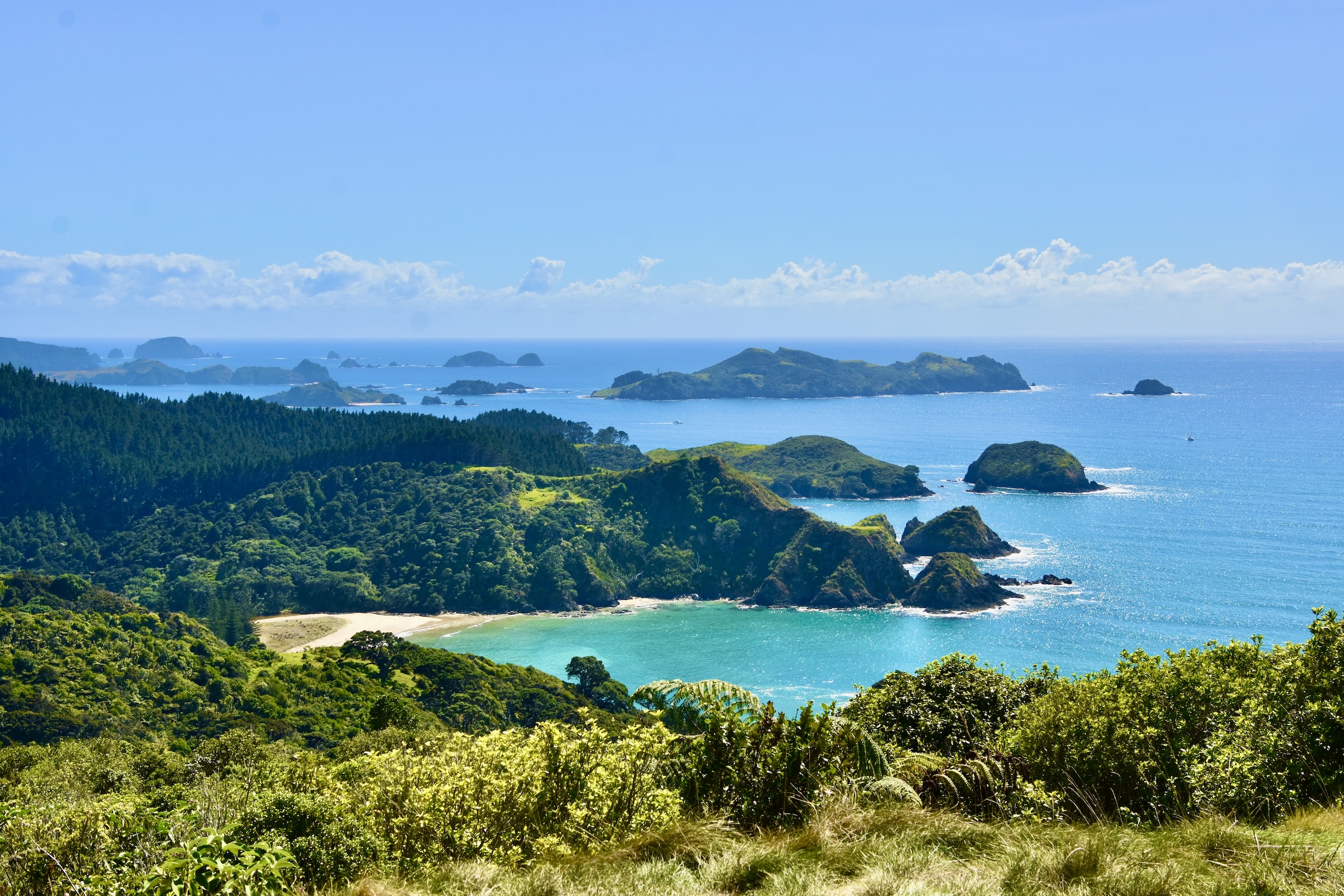
#16 Temptation – 326 Yard Par Four
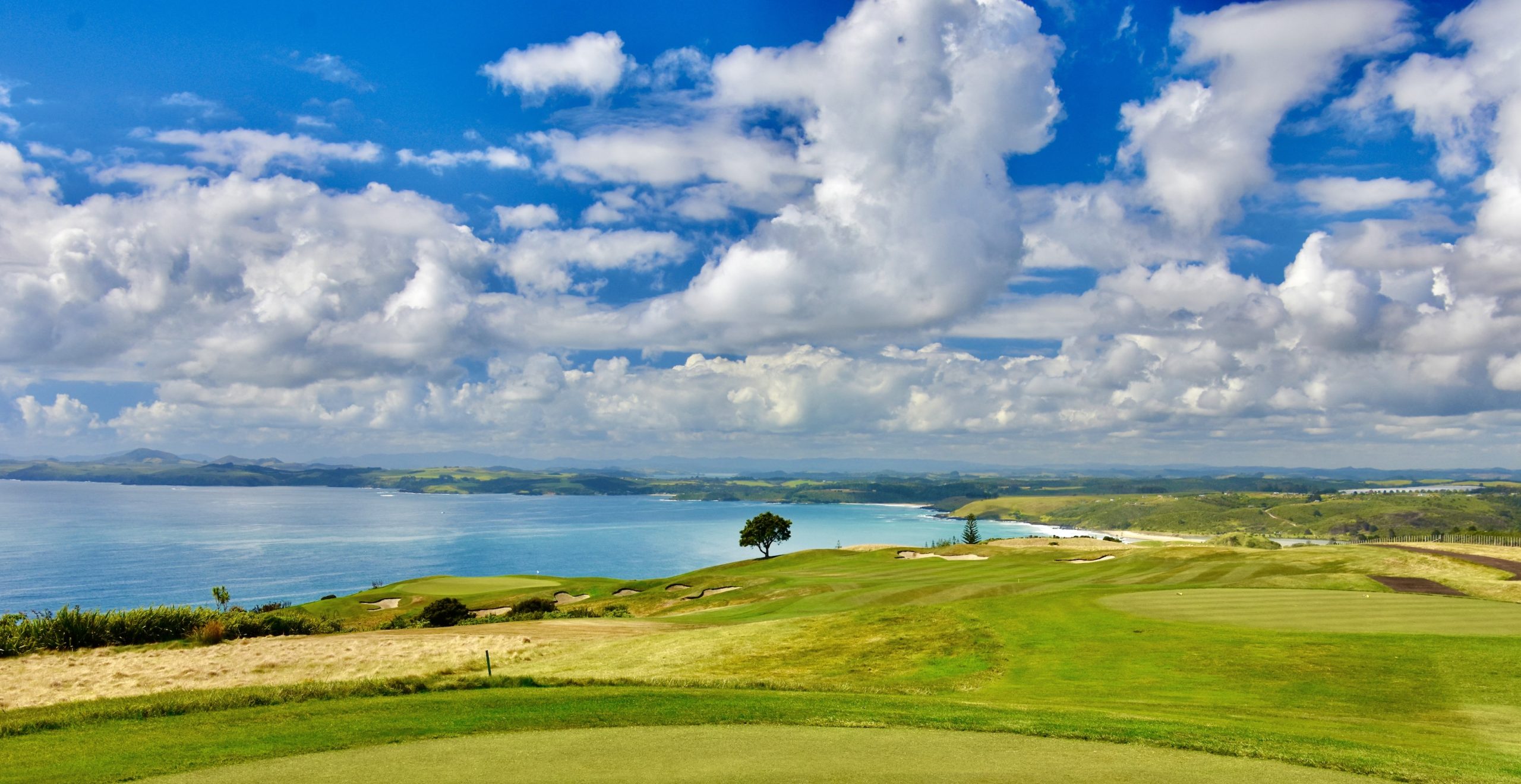
If I had a favourite hole visually at Kauri Cliffs it would be this stunning C-curve downhill par four with the broad expanse of Takou Bay in the background. If you are tempted to try to reach this green, as Adam Scott did with a three wood in 2008 from 367 yards, it is the devil who is tempting you. David Harman has set this hole up so that if you play it sensibly the natural downward flow of the fairway will get you as close as need be for your approach shot. What do I mean by sensibly? Take aim at the trap to the right of the large tree which is 250 yards from the green tees and you should land in front of it and roll and roll and roll.
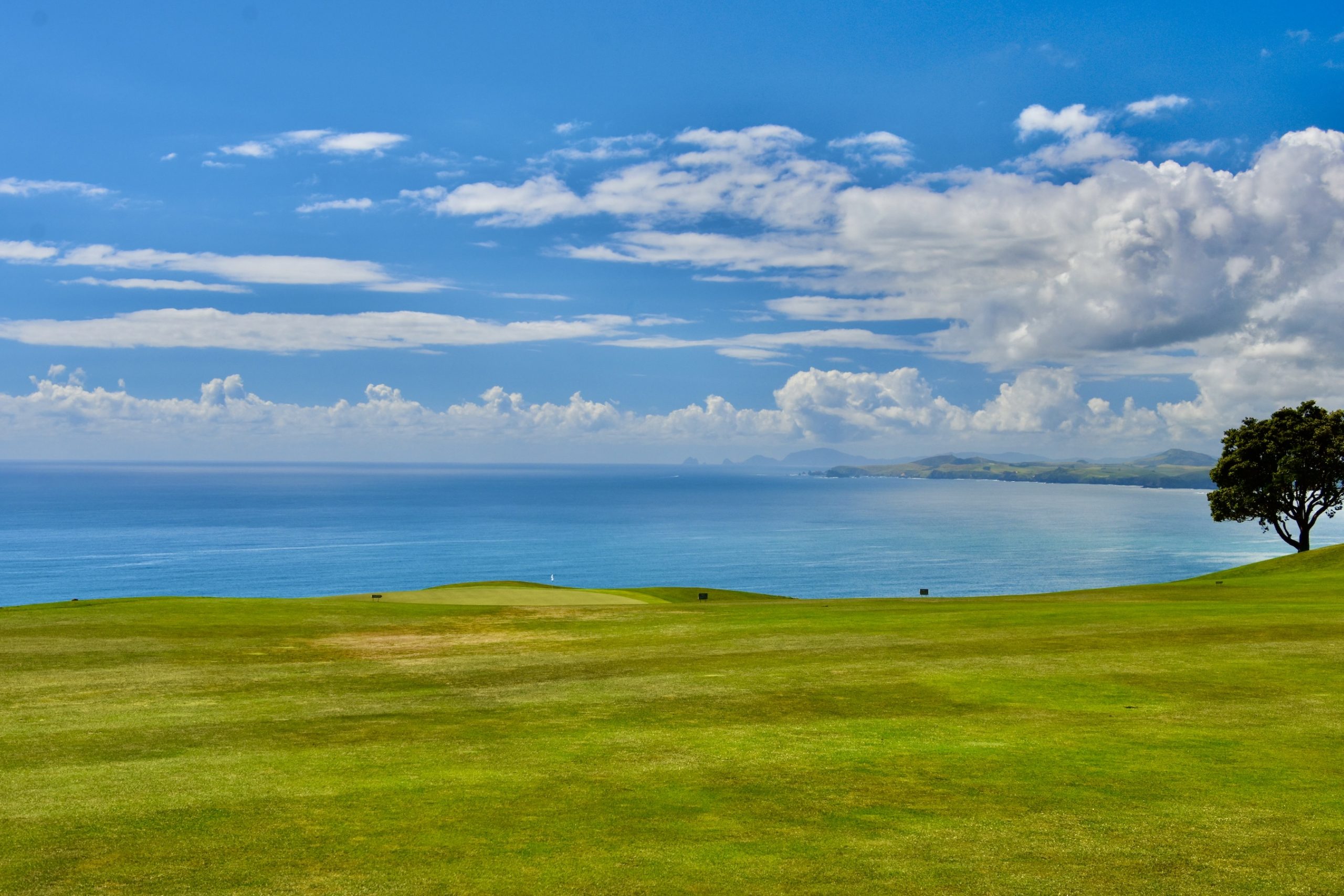
OK, I’m still a good distance out, but other than going long, the trouble is behind me. A gentle tap with a seven iron will run right down to the green for another good chance at birdie. I simply loved this hole and if there was one I had to play 18 times at Kauri Cliffs it would be #16.
Kauri Cliffs #17 Rainbow – 405 Yard Par Four
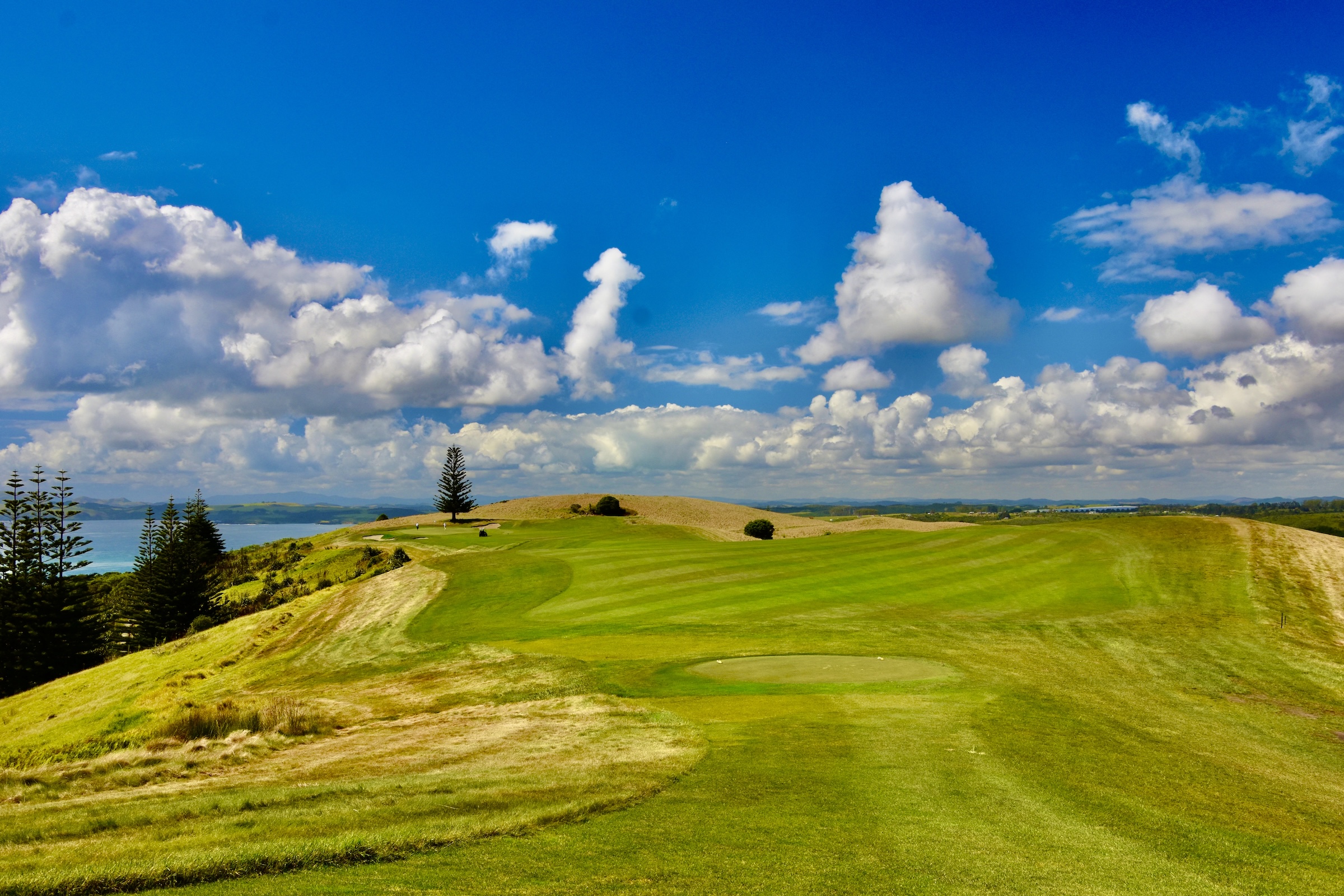
This is the #1 hole at Kauri Cliffs in terms of difficulty and this photo from the green tee box does not do it justice. While it’s a long hole from here, the drive is not particularly daunting with lots of room to try to bomb it down the right and kick back to the centre.
However, this is what it looks like from blue tees. OMG!

Back to reality, this is where I hit my third shot on #17 from. There something simply majestic about that lone Norfolk pine standing guard over the penultimate green at Kauri Cliffs.
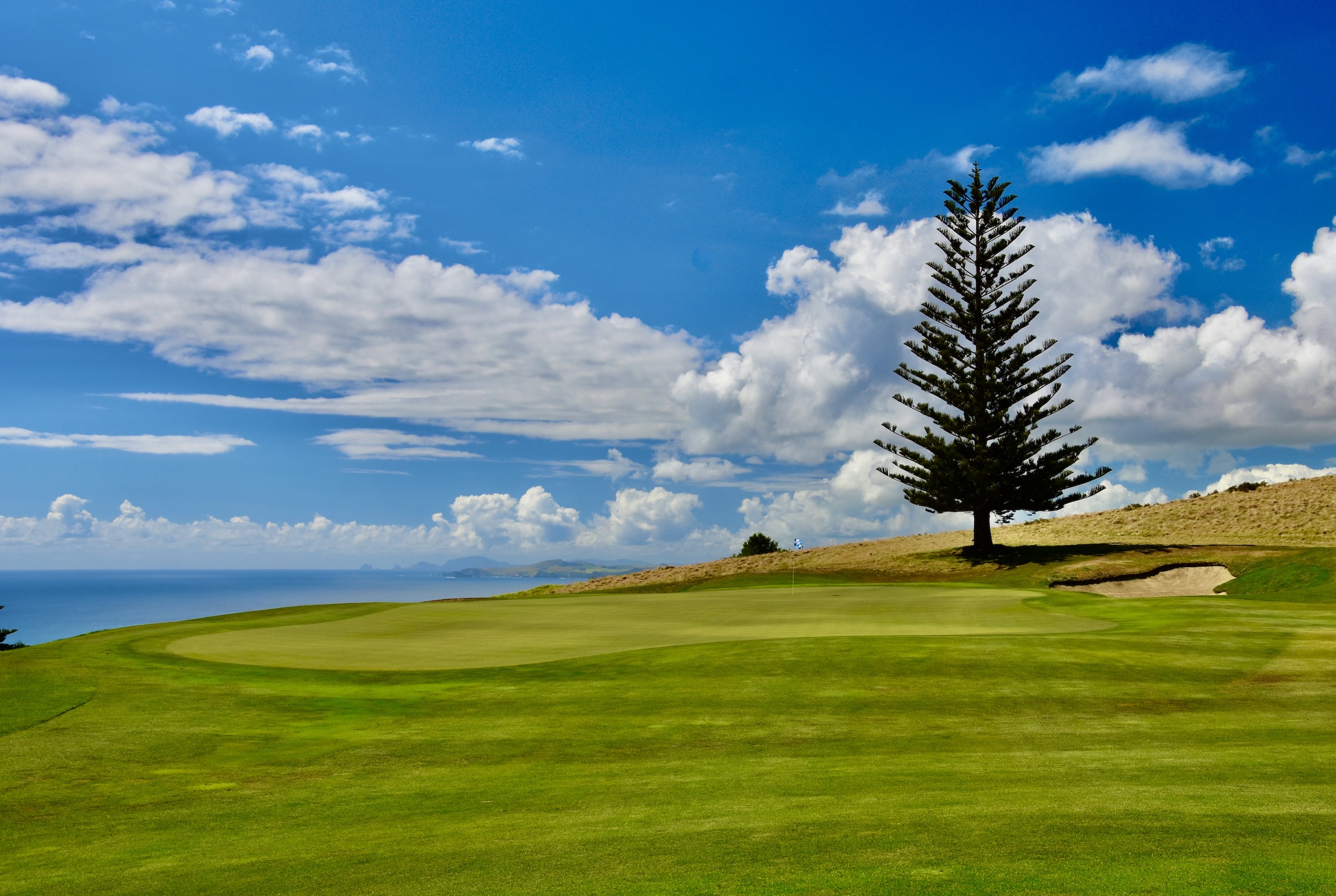
We now sadly must turn our back on the blue expanse of the Pacific Ocean and head home.
#18 Tane Mahuta – 470 Yard Par Five
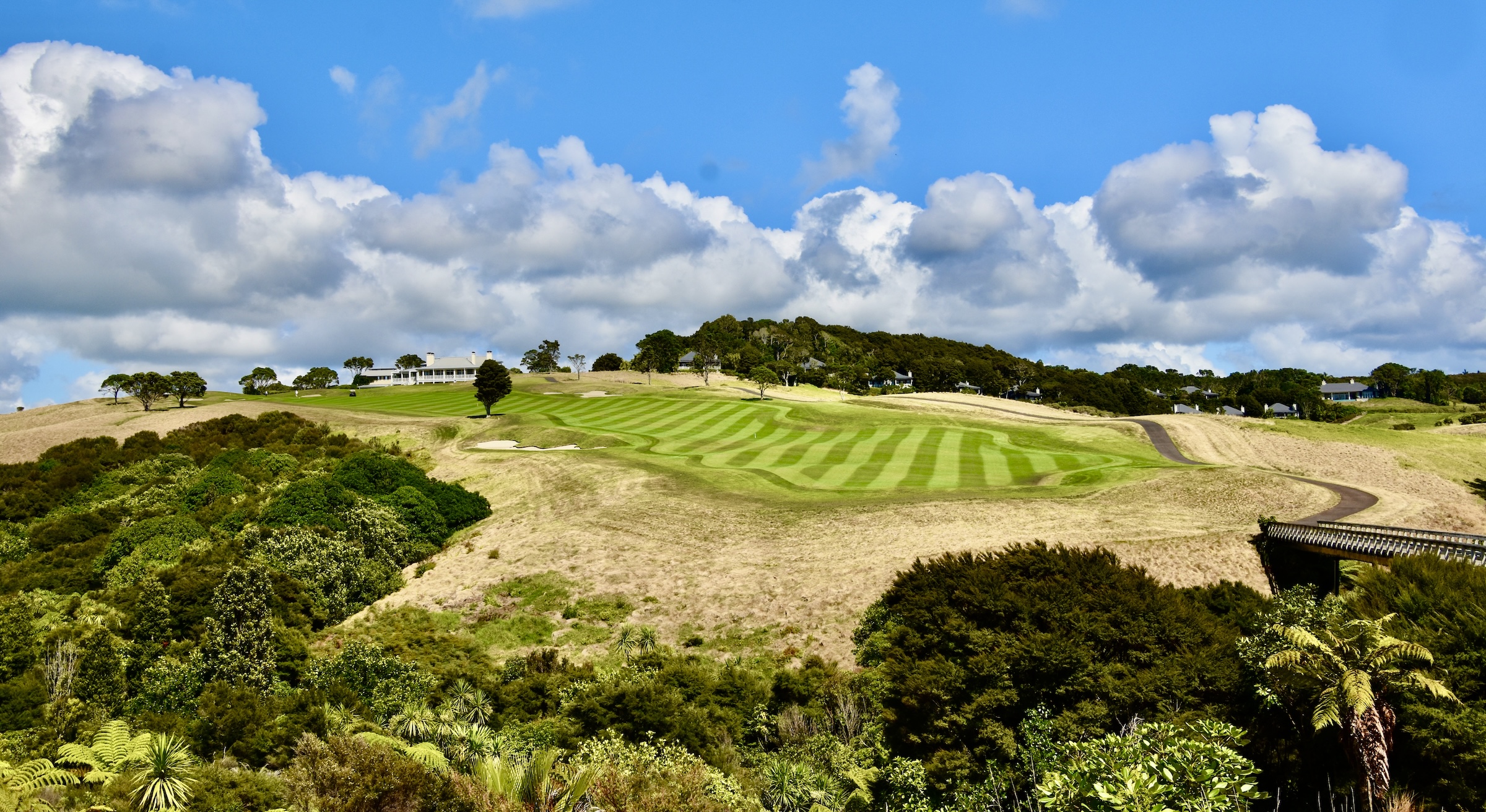
Tane Mahuta is the Maori god of the forest and the name of the largest kauri tree in the world. which a few days after playing Kauri Cliffs Alison and I visited in the Waipoua Forest. I highly recommend including a visit to this place in your Northland itinerary. It is truly magical.
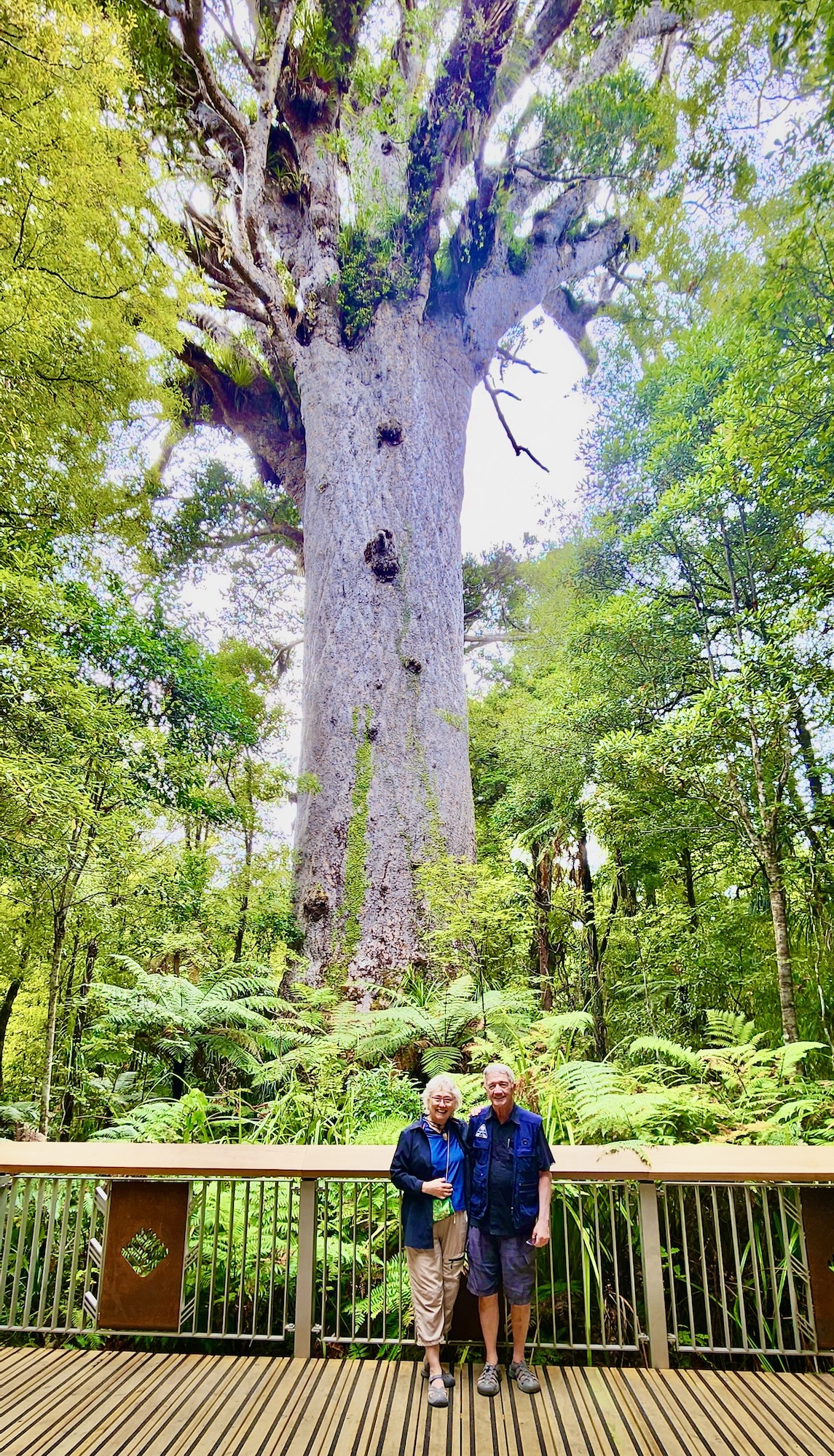
Back to magical golf. The carry on #18 is not as daunting as it appears from the tee box. It is only 209 yards to the bunker on the left side of the fairway. Stay well to the right and you should have a wide open second shot to leave a relatively easy approach shot to this multi-tiered green.
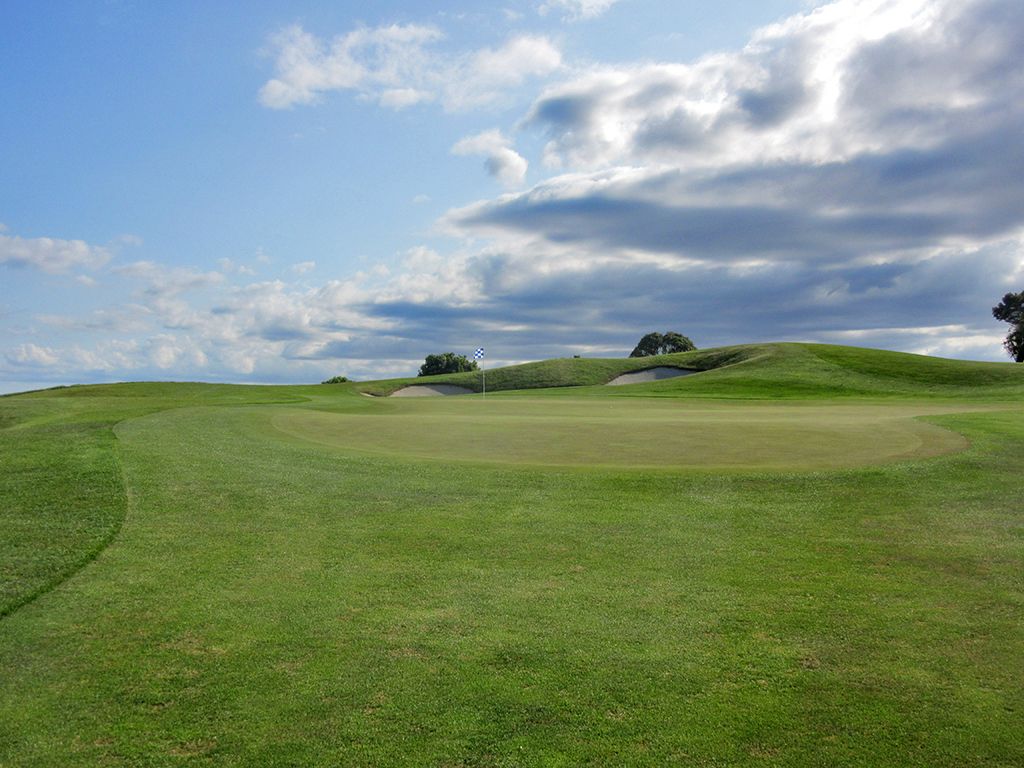
Writing this back in Canada some month after playing Kauri Cliffs, it really almost seems like a dream and believe me this is a course to dream about playing. I’m often asked if there was only one course you could play before checking out which would it be? There’s no easy answer as Old Head, the Plantation course at Kapalua, Kingsbarns and Whistling Straits all come to mind along with my own province’s Cabot Cliffs, but I would definitely put Kauri Cliffs on that very short list.
Kauri Cliffs is currently #55 on Golf Digest’s Top 100 courses list, inexplicably having fallen from #26 in its previous ranking. I have played about half the courses ranked ahead of Kauri Cliffs and I can tell you, without reservation, that it is a much better and more enjoyable to play course than most of those that precede it. I won’t name names, but just because you’ve hosted numerous Opens doesn’t mean you are automatically a Top 100 course.
Later on this tour of New Zealand, Alison and I will play Kauri Cliffs sister course, Cape Kidnappers and I look forward on giving a hole by hole description of that illustrious place as well.
However, in my next post we will spend some time in New Zealand’s major city Auckland where we will join our Adventures Abroad group in touring that great city.

